Acquaint SoftTech is a renowned Mobile app development company USA, India and our experienced developer proved it every day. We strive to deliver services in iOS app development, Android app development, E-commerce store development, custom app development, and enterprise development etc. We have a vast experience of serving in most industry i.e. Health, Business, E-commerce, Banking, Sports, B2B, B2C and so on. Our developers are capable of formulating your dream project in a profitable application. We always revere to our client's vision just to meets the expectation.
Last active 60 minutes ago
Don't wanna be here? Send us removal request.
Text
Introduction

Full-stack JavaScript development now often chooses the MERN stack. Combining MongoDB, Express.js, React.js, and Node.js into one potent stack helps create scalable, dynamic web apps. From social media to SaaS dashboards, developers depend on MERN to easily manage current workloads and ship products faster.
Regarding practical uses, though, speed by itself is insufficient. Not a feature, but rather a baseline need now is secure authentication in MERN stack apps. Even the best app ideas remain vulnerable to attacks, such as session hijacking, token theft, and data exposure, without robust user verification and access control.
This guide focuses on using proven techniques, including JWT authentication, bcrypt-based password hashing, and structured user authorization in MERN to implement a secure login MERN.
Understanding Authorization and Verification
Particularly in MERN stack apps, it is crucial to grasp the differences between authentication and authorization before diving into code.
Verifying the user's identity is the process of authenticity. It addresses the question: Are you indeed who you say you are?
The backend checks the credentials a user logs in with, email and password.
Authorization decides what the user is free to do. Do you have permission to access this resource?
Once the system identifies you, it looks at what data or actions you might be able to access depending on your roles or permissions.
Developers frequently apply both using JSON Web Tokens (JWTs) in MERN stack authentication. React, the frontend, sends credentials; the backend, Express + Node, checks and generates a signed token. Before granting access to guarded endpoints, MongoDB stores the user's role, which the app verifies.
Typical Security Concerns You Need to Attend
Ignoring security in MERN applications lets major hazards walk in. Here are some often occurring ones:
Automated bots search for several passwords to access. Brute force attacks. Attacks can, over time, guess credentials without rate limiting or account lockouts.
Should tokens or cookies be mishandled, attackers can pilfer active sessions and pose as users.
Saving plain-text passwords in MongoDB leaves enormous weaknesses. Use bcrypt or another similar method always to hash passwords.
Knowing these risks will help you make sure your application is both safe and functional, whether you intend to hire MERN stack developer or launch a small app. Giving user authorization top priority in MERN apps not only addresses backend issues but also directly helps to maintain user confidence and business reputation.
Setting Up the MERN Stack for Authentication

First of all, you have to know how every component of the MERN stack helps the workflow if you want to apply safe authentication in MERN stack applications. There is a stack comprising:
MongoDB keeps user information, including roles, tokens, and hashed passwords.
Express.js oversees the login, sign-up, and protected access API paths.
React.js uses HTTP requests to interface with the user and interact with the backend.
Node.js ties Express with MongoDB and runs the backend server.
Create a neat framework to prevent code bloat and security leaks before writing the first authentication line. This is a basic project architecture for a MERN authentication system with scalability:
/client
/src
/components
/pages
/utils
App.js
index.js
/server
/controllers
/middlewares
/models
/routes
/utils
config.js
server.js
How Does The Stack Align For Authentication?
MongoDB defines how user data is kept securely using schemas via Mongoose. Raw passwords are never saved.
Express reveals paths that cause controllers to run logic, including /api/auth/register and /api/auth/login.
React bases on app security requirements stores tokens in memory or localStorage and sends POST requests with credentials.
Sitting between the client and database, Node validates requests and responds securely using JWT tokens.
Keeping roles and permissions managed, you can now start integrating token-based flows, password hashing, and MERN stack authentication logic from this foundation.
Implementing Safe User Registration

Any MERN stack login system starts with user registration. Strong registration shields your app against database compromise, weak passwords, and injection attacks. You have to hash passwords, validate information, and carefully save credentials.
1. Verifying User Commentary
Starting frontend validation with libraries like Yup or React Hook Form. This guarantees a quick response and helps to prevent pointless API calls.
Re-evaluate the same inputs always on the backend. Verify using express-validator or hand-made schema checks:
Email style is correct.
Passwords fulfill minimum complexity (length, symbols, uppercase).
The input contains no hostile scripts.
Never depend just on client-side validation. Validation has to exist server-side to prevent API call bypass.
2. bcrypt-based Hash Password Generation
Store passwords not in plain text but with bcrypt. Salted hashes created by bcrypt make reverse engineering quite challenging.
Javascript
const bcrypt = require('bcryptjs');
const hashedPassword = await bcrypt.hash(req.body.password, 12);
Tip: Use a salt round between 10 and 12 to strike a reasonable mix between performance and security. Store just the hashed output into MongoDB.
3. MongoDB User Credentials Stored
Generate a user Mongoose model. Make sure your schema just takes cleaned, hashed data. This is a basic illustration:
Javascript
const userSchema = new mongoose.Schema({
email: { type: String, required: true, unique: true },
password: { type: String, required: true },
role: { type: String, default: 'user' }
});
MERN apps let one extend this model with timestamps, verification tokens, or user authorization roles. These actions turn your safe login on the MERN stack production-grade one. Sensitive information stays encrypted at rest; registration paths remain under protection.
Implementing Secure Login

Designing a login system that guarantees identity verification without revealing user information comes next in MERN stack authentication, following secure registration. JSON Web Tokens (JWT), HTTP-only cookies, and common attack defenses all come into play here.
Check with JWT authentically
Create a JWT on the backend when a user logs in with legitimate credentials. Signed with a secret key, this token bears encoded user information. This is a fundamental flow:
Javascript
const token = jwt.sign({ userId: user._id }, process.env.JWT_SECRET, {
expiresIn: '1d'
});
Send the token in the response body (with care) or return it to the frontend using HTTP-only cookies. Through identification of legitimate sessions, the token helps guard private paths and resources.
Store Tokens Using HTTP-only Cookies
Use HTTP-only cookies instead of local storage, which is vulnerable to XSS attacks JWT storage. Only sent in server requests, this kind of cookie cannot be accessed with JavaScript.
Javascript
res.cookie('token', token, {
httpOnly: true,
secure: true,
sameSite: 'Strict',
maxAge: 86400000
});
Fight XSS and CSRF Attacks
Shield the MERN app from typical attack paths for safe login. Using these measures guarantees not only functional but also perfect user authorization in MERN applications. When combined with the secure authentication in MERN stack, your login system becomes a strong basis for user and business data protection.
Sanitize all user input, especially form fields and URLs, XSS, Cross-Site Scripting. React or server validation middlewares can be found in libraries like DOMPurify.
Always use cookies, always apply CSRF protection using custom tokens, and sameSite: strict settings. Express apps call for middleware like csurf.
Safeguarding User Information and Routes
Route protection is a must in every secure authentication in MERN stack system. Once a user logs in, middleware in your Express backend must confirm their access to specific endpoints.
Middleware for Routes Protected
Token verifying JWT-based authentication limits access. Add middleware to see whether the token exists and is legitimate.
javascript
const verifyToken = (req, res, next) => {
const token = req.cookies.token;
if (!token) return res.status(401).json({ message: 'Unauthorized access' });
jwt.verify(token, process.env.JWT_SECRET, (err, decoded) => {
if (err) return res.status(403).json({ message: 'Invalid token' });
req.user = decoded;
next();
});
};
Role-Based Access Control (RBAC)
Authorization goes beyond login. After secure authentication in MERN stack, validate the user’s role to apply role-based access control. For example:
js
const isAdmin = (req, res, next) => {
if (req.user.role !== 'admin') {
return res.status(403).json({ message: 'Admin privileges required' });
}
next();
};
Real World Case Study
Hiring MERN stack developers to create a product dashboard will mean limiting access depending on user roles. While standard users can only view their data, administrators can oversee users. These guardrails enable responsibility and help to preserve data integrity. Combining route protection with RBAC gives your user authorization in MERN airtight, dependable, and production-ready form.
Ideal MERN Stack Authentication Practices

You have to surpass login forms and tokens to create really secure authentication in MERN stack applications. Your management of your environment, contacts, and code hygiene will determine the foundation.
Guard Environmental Variables
Never hardcode secrets, including JWT keys, database URIs, or API credentials. Store them in a .env file, and dotenv loads them securely. Include .env in to gitignore to prevent leaking secrets into version control.
Js
require('dotenv').config();
const jwtSecret = process.env.JWT_SECRET;
Apply HTTPS and Secure Headers
Every production app runs over HTTPS. Token and sensitive data leaks from unsecured endpoints. Create HTTP headers like:
Tight-Transport-Security X-Content-Type-Choice Options
Policy for Content Security
Clickjacking, content sniffing, and cross-site scripting (XSS) are prevented in part by these headers.
Maintain Dependencies Current
Many well-known weaknesses reside in antiquated packages. Scan for and quickly fix problems using npm audit, Snyk, or GitHub's Dependabot. Manage MERN stack authentication and user sessions, avoiding obsolete libraries.
Bottomline
MERN stack applications now require secure authentication; it is not a choice. It builds trust, safeguards user data, and increases the resilience of your application in manufacturing settings.
Every action counts, from knowing how secure authentication in MERN stack
differs from authorization to configuring JWT-based login, hashing passwords with bcrypt, and safeguarding paths with role-based access control. Maintaining one step ahead of actual threats requires following best practices, including securing environment variables, enforcing HTTPS, and keeping your stack current.
In a world where web breaches are a daily headline, getting secure authentication in MERN stack right means everything. You now know how to structure your project, secure your routes, protect your users, and keep your system airtight from the start!
Do share the blog if you find it helpful!
0 notes
Text
Early Hiring Failure and How Staff Augmentation for Startups Saves?
Introduction
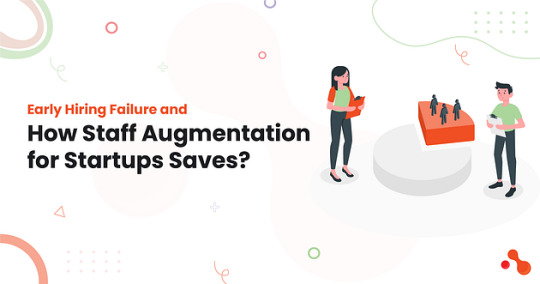
Startups collapse not just because of weak ideas but often due to hiring the wrong people at the wrong time. Poor hiring choices in the early stages burn through budgets, delay product timelines, and stall momentum when speed matters most. The biggest startup hiring mistakes come from rushing to fill roles without a clear product-market fit or engineering clarity!
Founders often overhire or hire too soon, investing in full-time staff before validating their business model. This leads to bloated payrolls, mismatched skills, and decision bottlenecks. Instead of agility, the startup becomes locked into rigid headcounts and underperforming teams. This is where staff augmentation for startups changes the game.
Top Reasons Why Startups Fail at Hiring Early
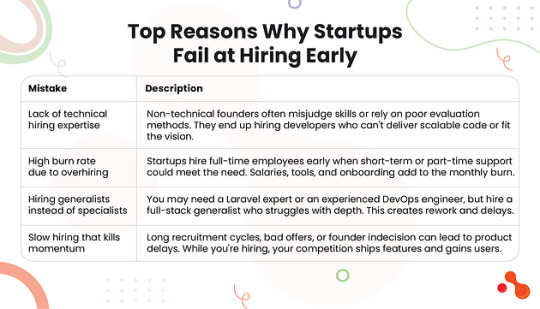
Inside story: These startup hiring mistakes happen because early-stage founders lack time, resources, or the network to build the right team quickly. That’s why they need faster and more flexible ways to access top talent!
How Staff Augmentation Solves Early Startup Hiring Problems?
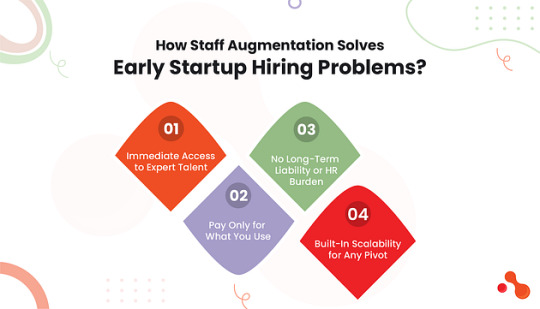
When traditional hiring slows you down or drains your runway, staff augmentation for startups offers a smarter alternative. It fixes early hiring failures by offering speed, control, and flexibility, without the overhead of building an in-house team.
Immediate Access to Expert Talent
With staff augmentation, startups can instantly onboard skilled professionals who already know how to build and ship. Whether you need remote MVP developers for hire or a Laravel specialist for a backend module, you get results without going through months of interviews.
Pay Only for What You Use
You can hire on an hourly or monthly basis. There’s no wasted spend on idle capacity or bloated salaries. This model ensures cost efficiency at every stage of product development.
No Long-Term Liability or HR Burden
Forget about contracts, employee benefits, taxes, or compliance issues. Augmented staff work under flexible agreements, and you’re free to scale down with no HR bottlenecks.
Built-In Scalability for Any Pivot
Your startup may pivot, scale up suddenly, or face funding delays. Staff augmentation lets you adjust resources instantly. You can add more developers or reduce bandwidth as priorities change, without harming velocity or morale. The benefits of staff augmentation are clear: it lets you move fast, stay lean, and build smarter from day one.
Staff Augmentation vs. Full-Time Hiring for Startups
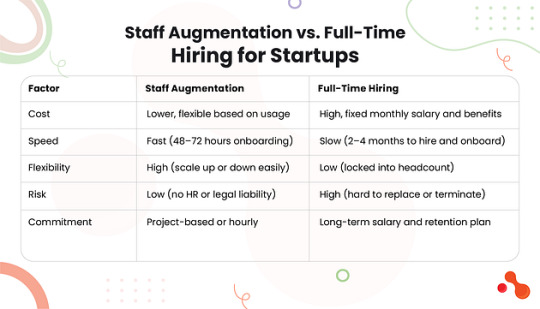
Common Startup Scenarios Where Augmentation Is Better
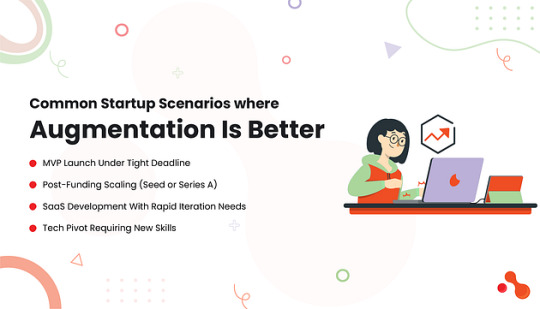
Here are real-world situations where augmentation makes more sense:
MVP Launch Under Tight Deadline
Launching an MVP often comes with fixed investor expectations and a short runway. Augmentation allows you to hire remote Laravel developers for startup projects within days, not months. This speeds up delivery without sacrificing code quality or team control.
Post-Funding Scaling (Seed or Series A)
Once funding arrives, startups need to scale fast. Instead of spending three months hiring, founders can bring in multiple developers on contract to accelerate product updates, feature rollouts, and architecture redesigns.
SaaS Development With Rapid Iteration Needs
SaaS startups must release updates regularly based on user feedback. Staff augmentation gives access to skilled developers who can build, test, and deploy in short sprints. You can avoid bottlenecks without inflating payroll!
Tech Pivot Requiring New Skills
When your product shifts from Web2 to Web3, or from monolith to microservices, your old team may not have the required skill set. Augment your core with specialists who bring that exact expertise without hiring full-time.
In all these cases, startups save time, money, and bandwidth by partnering with the best staff augmentation company for startups, one that understands early-stage urgency and tech specificity.
Real Startup Examples: Failing Fast vs. Scaling Smart
The following examples show how two early-stage startups took different paths, with drastically different outcomes.
��� Startup A: Hired Fast, Burned Out Faster
Startup A raised a small seed round and rushed to build its MVP. The founder, with no technical background, hired a full-time in-house team of five developers in just four weeks. Without proper vetting or role clarity, they overbuilt features, missed critical deadlines, and created tech debt that slowed progress.
In six months, the startup burned over $300,000 in salaries, tools, and office space. No product shipped. Investors lost confidence. The company shut down before reaching the market.
✅ Startup B: Augmented Right, Launched on Time
Startup B, working with a similar budget, chose staff augmentation for startups. They brought in remote MVP developers for hire from a trusted agency. Instead of hiring full-time, they paid hourly for a project-based team via flexible model options.
Within five months, they launched a clean, functioning MVP. Their burn rate stayed low. They saved over 50% in upfront costs and secured follow-on funding after the product gained traction. These outcomes show the power of choosing the right hiring model.
How to Implement Staff Augmentation Strategically?
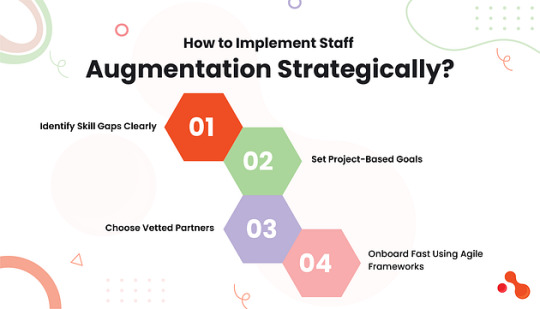
Choosing staff augmentation for startups works only when done with clarity and intent. You need to know what to build, who to bring in, and how to manage their output. Follow this strategic approach to make augmentation effective from day one!
Identify Skill Gaps Clearly
Start by auditing your current team.
Do you lack frontend capacity?
Need backend specialists like Laravel developers?
Or product designers for an MVP sprint?
Define exact roles and skills before reaching out for external help!
Set Project-Based Goals
Augmented developers perform best when assigned to specific outcomes. Don’t onboard them to “help the team.” Instead, tie each resource to milestones like a working prototype, API integration, or testing phase.
Choose Vetted Partners
Work with the best staff augmentation company for startups, one that understands tech stacks, agility, and startup pace. Agencies like Acquaint Softtech provide proven developers who can plug in fast, adapt to your tools, and build real products.
Onboard Fast Using Agile Frameworks
Use agile tools like Jira, Trello, or Asana for sprint planning. Assign Git access, set up Slack channels, and define standup routines. When you onboard right, remote engineers feel like part of the core team from day one.
Also read: Top ways IT staff augmentation empowers tech startups!
Bottomline
In the early stages of a startup, hiring decisions determine product velocity, cost efficiency, and long-term sustainability. Moving quickly is important, but making the right hiring developer choice is essential for survival. Full-time hiring at the wrong stage can lead to wasted capital, missed deadlines, and irreversible damage to growth momentum.
Staff augmentation for startups offers a strategic alternative. It allows founders to access specialized talent, reduce overhead, and scale operations based on real-time business needs. Instead of locking into fixed salaries, you gain the ability to allocate resources where they deliver the most value.
The most successful startups today prioritize flexibility, skill alignment, and speed. Staff augmentation supports all three, giving your venture the foundation to build fast, scale smart, and respond to change effectively.
#startup hiring mistakes#early hiring problems in startups#benefits of staff augmentation#remote MVP developers for hire
0 notes
Text
Mastering Remote Software Development: Top Strategies for 2025
Introduction
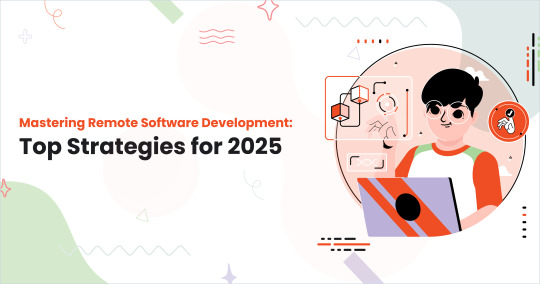
In 2025, businesses that outperform their competitors do one thing exceptionally well, they hire dedicated remote developers to unlock speed, scalability, and technical precision. As global talent becomes more accessible and digital infrastructure matures, remote-first development has evolved from a temporary fix into a permanent competitive advantage.
This shift is a change in how modern product engineering works. Agile companies now tap into specialized global talent pools, reduce overhead, and scale faster by building remote developer teams aligned with long-term goals.
The Rise of Remote Software Development in 2025
According to a report, 82% of tech companies reported higher productivity with remote teams compared to in-house models. Remote setups allow teams to skip commutes, work with fewer distractions, and align around async processes that prioritize output over time spent.
The rise of remote-first development has globalized tech hiring, giving companies access to elite skill sets they previously couldn’t afford or find locally. Whether you need DevOps engineers in Poland, full-stack developers in India, or AI specialists in Brazil, distributed development models enable these partnerships to be fast, efficient, and cost-effective.
Key Challenges in Remote Software Development
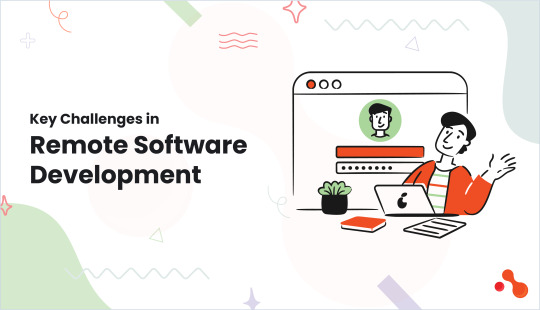
While many companies move fast to hire dedicated developers, they often overlook the operational challenges that come with managing a remote development model. The benefits are immense, but so are the risks if you don’t implement the right processes early on!
Communication Gaps Across Time Zones
One of the biggest roadblocks to remote software development success is the time zone divide. Without a clear overlap window or asynchronous communication standards, updates can lag. Smart organizations use strategies for managing remote developers, like “follow-the-sun” models or rotating standups, to maintain continuous velocity.
Code Quality Maintenance in Distributed Environments
Teams that hire dedicated remote developers without a unified development workflow often face issues like merge conflicts and inconsistent coding standards. Adopting CI/CD pipelines, mandatory code reviews, and shared repositories helps enforce quality across the board.
Building Team Culture Remotely
The benefits of remote development teams come at a cost. While they offer flexibility and access to a global talent pool, it’s also important to factor in the actual cost to hire remote developers. Beyond financial considerations, new hires can sometimes feel isolated from the team. To overcome this, successful firms invest in virtual rituals, build shared knowledge systems, and implement mentor pairing programs—ensuring remote developers stay engaged and connected.
Security and IP Protection Issues
When you hire remote developers, data protection becomes critical. From using secure VPNs and password managers to ensuring non-disclosure agreements (NDAs) and encrypted codebases, every access point must be locked down. Companies that neglect IP protocols face unnecessary legal and reputational risks, especially when working with freelancers or unvetted partners.
Top Strategies for Remote Development Success

To hire dedicated developers and scale a distributed team effectively in 2025, startups need more than great code. They need scalable systems, smart collaboration processes, and cultural glue that holds remote developers accountable and motivated. It’s also worth understanding the difference between hiring remote developers vs an in-house team to choose the best strategy for sustainable growth.
From selecting the right partner to enforcing secure dev environments, these strategies bring remote software development success within your grasp:
Hire Dedicated Remote Developers with Proven Experience
Startups often rush to hire remote developers for your tech startup based solely on resumes or portfolios. But paper qualifications rarely prove readiness for distributed workflows.
Key tips to get this right:
Use trusted hiring platforms or hire dedicated remote developers through companies that provide pre-vetted, project-ready candidates.
Verify past remote experience. Developers used to local sprints may not adapt well to async communication or autonomous execution.
Ask for live coding tests, real-world GitHub contributions, and DevOps readiness to judge their ability across delivery pipelines.
Example:
Acquaint Softtech provides clients with Laravel and MERN developers who have passed multi-round technical screenings, timezone overlap evaluations, and culture fit interviews, giving startups access to a hire dedicated remote team with zero onboarding delay.
Build a Strong Remote Development Culture
A strong culture creates invisible alignment. It bridges the physical gaps and prevents silence from turning into stagnation.
What must founders do?
Make your roadmap accessible and regularly updated via Notion or Confluence.
Promote radical transparency using async updates on Slack and dashboards that track real progress.
Encourage peer learning with weekly code reviews, brown bag sessions, and pair programming rituals.
Best Practice:
Use emojis, GIFs, or virtual coffee chats to inject human connection. These small acts go a long way in reinforcing a remote team development best practices culture.
Implement Agile Methodologies for Distributed Teams
Remote doesn’t mean unstructured. Without the discipline of Agile, remote teams drift, misalign, and miss deadlines.
Best ways to apply Agile remotely:
Use tools like Jira or ClickUp for sprint planning and ticket-level tracking.
Schedule weekly demos and stakeholder reviews to drive accountability and showcase progress.
Add sprint retrospectives, even asynchronously, to address roadblocks and keep communication flowing.
Why does it work?
Distributed Agile promotes faster iterations, reduces the risk of over-engineering, and gives hire dedicated developers a clear structure and cadence.
Prioritize Secure Development and IP Protection
In remote models, your source code, product logic, and even user data might be accessed from hundreds of miles away. Without proper controls, this opens doors to risk.
Foundational practices for secure dev environments:
Sign NDAs and IP Transfer Agreements before the first commit.
Ensure developers use VPNs, 2FA-enabled Git access, and encrypted storage for any shared credentials.
For SaaS, implement Role-Based Access Control (RBAC) and regularly rotate credentials using tools like HashiCorp Vault or AWS Secrets Manager.
What smart CTOs do?
They enforce access monitoring and integrate security audits as part of CI/CD pipelines. This ensures their scalable backend architecture remains protected even across continents.
Use the Right Tools for Communication, Collaboration, and Monitoring
Even top-tier developers fail without strong toolchains. The right tools transform intention into execution.
Must-have stack for remote success:
Communication: Slack for real-time messages, Loom for async updates, Google Meet for demos.
Collaboration: Jira or Trello for task boards, GitHub for codebase management, Notion for documentation.
Monitoring: Jenkins and GitLab for CI/CD, Sentry for live error reporting, and Grafana for performance visualization.
Why do tools matter?
Tools allow teams to focus on system performance optimization instead of chasing updates or tickets. This plays a critical role when you hire dedicated developers and want them to integrate fast.
Invest in Documentation and Knowledge Sharing
Too many startups skip documentation in the early days. That mistake costs dearly when the scale hits!
How to avoid that trap?
Maintain API documentation, architecture diagrams, and deployment workflows in Notion or GitBook.
Schedule monthly tech talks or “show and tells” for cross-learning for hire dedicated remote team.
Encourage devs to document edge cases, failed experiments, and system scaling notes in tickets or internal wikis.
Why does this work?
Shared knowledge reduces developer dependency, increases autonomy, and makes your application architecture for growth more resilient.
Best Practices for Scaling Remote Development Teams
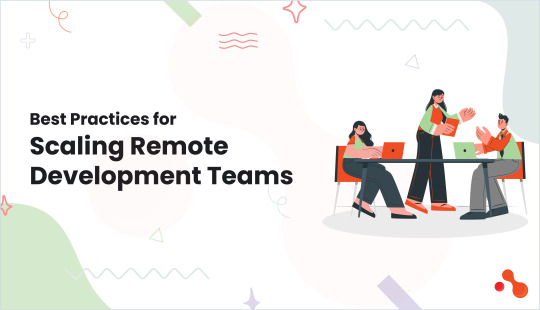
You must build remote software development success on repeatable systems, documented processes, and strategic investments that support fast-paced execution.
Here’s how growth-focused startups in 2025 are scaling their remote development teams the smart way!
Start Small, Scale with Intent
Don’t begin with a bloated structure. Start with a core product team, usually a backend developer, a frontend expert, and a DevOps lead. Once early product milestones are hit, expand based on clear deliverables and velocity metrics.
Why does it work?
Creates tight feedback loops early
Ensures remote team development best practices are established before scale
Makes it easier to optimize processes and identify blockers
Standardize Onboarding and Documentation
Every new developer must hit the ground running. Without documented workflows, ramp-up time grows and productivity stalls. Build centralized onboarding documentation, covering codebase setup, repo access, CI/CD usage, task management tools, and coding standards.
Recommended documentation tools:
Notion or Confluence for onboarding wikis
Loom for walkthrough videos
Google Drive or GitBook for SOPs
Embrace DevOps and Early Automation
Automation lays the foundation for performance and scalability. Introduce DevOps practices from day one, not as an afterthought. It directly contributes to system performance optimization and keeps product velocity consistent.
Automation best practices:
CI/CD pipelines via Jenkins or GitHub Actions
Linting and unit tests in pull request pipelines
Environment consistency through Docker and Kubernetes
Deployment monitoring via Prometheus and Grafana
Build a Culture of Async Accountability
As your team grows, async workflows become critical. Introduce strategies for managing remote developers that promote ownership and time-independent progress!
Tactical actions:
Record all sprint reviews for async viewing
Encourage video-based updates for clarity
Use tools like Status Hero for daily async standups
Prioritize Growth-Ready Architecture Early
You must design your backend to scale before your users scale. Structure your app with application architecture for growth from the beginning.
What this includes:
Modular architecture with microservices or domain-driven modules
Cloud-native deployment with horizontal scaling built in
Logging and error-tracking tools to spot bottlenecks before they hit production
How Startups and SaaS Companies Can Benefit Most?

Startups and SaaS founders operate in an environment where agility, speed, and cost-efficiency directly influence survival. For these companies, remote development is a strategic edge that fuels smarter growth.
Lower Burn Rate, Higher Runway
Launching a tech product with an in-house team in the US or UK can exhaust early-stage funding quickly. Remote development models allow startups to reduce development costs by 40–60%. This financial efficiency empowers longer experimentation, better user feedback, and sustainable growth without needing to compromise on quality.
Faster MVP Development and Iteration
Speed is currency in early-stage product launches. Distributed teams, when structured right, can ship MVPs in half the time. With the right practices in place, startups can build, launch, gather user feedback, and iterate fast. This agility is critical in competitive SaaS markets where early mover advantage and feedback loops are gold.
Dynamic Scaling Based on Demand
Founders don’t need to predict how big the team should be upfront. Remote-first models support flexible scaling aligned to funding rounds, traction milestones, or user surges. This elasticity helps startups adapt to rapid changes without compromising on performance or delivery.
Bottomline
To hire dedicated remote developers successfully, companies must focus on structure, security, and cultural alignment. It is about building a resilient delivery engine that runs smoothly across time zones. This means choosing developers who understand your domain, implementing secure systems, and using battle-tested remote development best practices.
With proper sprint planning, strong communication tools, and DevOps automation, remote teams can outperform even traditional in-house setups. The future belongs to companies that can scale quickly, adapt instantly, and deliver reliably.
By embracing this model, businesses unlock growth-ready architecture, streamline product velocity, and drive outcomes that investors and users care about. From MVPs to enterprise-grade platforms, the remote model proves its worth at every stage!
Original Source: https://medium.com/@mukesh.ram/mastering-remote-software-development-top-strategies-for-2025-c3c4f73e3b2e
#Remote Software Development#Software Development#Benefits of Remote Development Teams#Hire Remote Developers#Hire Dedicated Developers#Dedicated Remote Developers
0 notes
Text
WordPress Statistics 2025: Market Share, Usage, and Trends
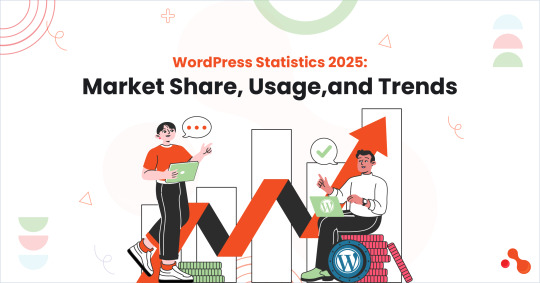
WordPress statistics 2025 show that the platform remains the most dominant content management system in the world. It powers a wide range of websites, including blogs, online stores, media outlets, and business platforms of every size.
For developers, agencies, and businesses, understanding WordPress market share 2025 and how usage patterns are shifting is essential. These insights help in making informed decisions about design practices, hosting environments, and future development work.
In this blog, we’ll cover the most recent WordPress statistics 2025, including global adoption rates, plugin and theme usage, and real trends across regions and industries.
WordPress in 2025: A Quick Snapshot
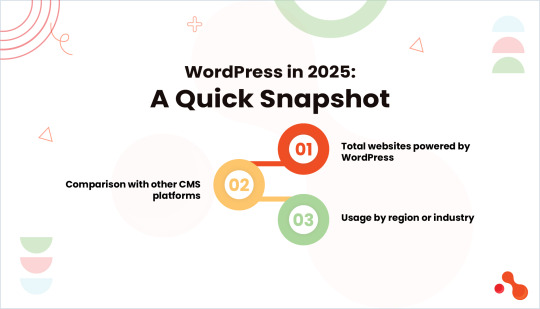
Total websites powered by WordPress
WordPress statistics 2025 report that 43.4 % to 43.6 % of all websites worldwide run on WordPress. Depending on which source you read, that equates to roughly 529–535 million websites using the platform.
Comparison with other CMS platforms
When focusing on websites that use a known content management system, WordPress holds an even stronger position. It captures 61–62.7 % of CMS-based sites, with its nearest competitors Shopify, Wix, and Squarespace, each holding between 3–7 %
Breaking it down:
Shopify: ~4.6–6.7 %
Wix: ~4–5.4 %
Squarespace: ~3–3.3 %
Joomla and Drupal: each around 1–2 %
Usage by region or industry
Although specific breakdowns by region or industry are not summarized in one dataset, we can infer some patterns from the global usage:
North America and Europe both break into high adoption, accounting for nearly half of all WordPress sites.
Emerging markets in Asia-Pacific, Latin America, and Africa all show strong uptake as mobile-first site development becomes a priority.
When it comes to industry, WordPress is the go-to platform for blogs, small businesses, media publishers, and growing eCommerce sites, especially those powered by WooCommerce.
WordPress Market Share in 2025

According to the latest WordPress statistics 2025, the platform holds a global CMS market share of approximately 62.7% among websites using a content management system. This figure has remained relatively stable compared to the past two years, indicating continued dominance and long-term trust in the WordPress ecosystem.
When looking at WordPress market share 2025 in context, the numbers reflect consistent leadership:
In 2021, WordPress held around 39% of all websites
In 2023, the share climbed to 42.9%
As of mid-2025, the figure is at 43.4% across all websites and over 62% in CMS-specific usage
This slow but steady climb highlights the platform’s strong position across both technical and non-technical user bases.
So, why does WordPress continue to lead?
The reasons are practical:
A vast ecosystem of plugins, themes, and tools
Easy access to freelancers and any WordPress website development company
Compatibility with modern technologies, including headless frameworks and third-party integrations
More importantly, updates in recent versions have focused on user experience, performance, and accessibility. These improvements have helped maintain WordPress’s popularity across industries, especially in sectors that rely heavily on scalable content, such as publishing, e-commerce, and education.
For those involved in WordPress website design and development, this ongoing dominance means the platform is still the safest and most strategic bet for client projects, personal brands, or even product sites in 2025.
Key Usage Statistics
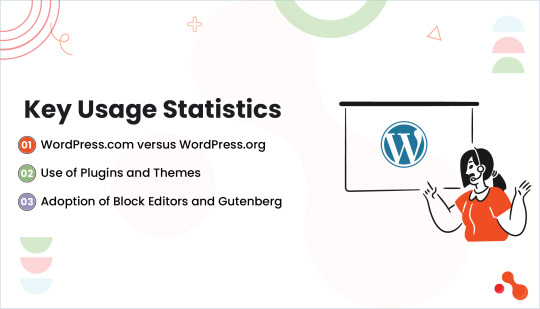
In 2025, the WordPress ecosystem will have grown significantly. According to current estimates, there are between 529 and 535 million active WordPress websites, which make up more than 43% of all websites on the internet. These figures show the platform's size as well as its continued significance in the development of the contemporary web.
WordPress.com versus WordPress.org
The majority of developers, agencies, and business owners still favor WordPress' self-hosted version, which is accessible via WordPress.org. It provides access to thousands of plugins and themes, complete control, and customization. However, WordPress.com, which offers a hosted version with fewer customization options and a simpler setup, continues to serve a sizable user base, particularly among smaller websites and personal bloggers.
WordPress.org powers about two-thirds of all WordPress websites, with WordPress.com powering the other third. The self-hosted option is preferred due to its adaptability, superior plugin support, and appropriateness for designing and developing business-grade WordPress websites.
Use of Plugins and Themes
With new entries being added every day, the WordPress plugin directory has surpassed 60,000 entries. Installs are still dominated by plugins like Yoast SEO, Elementor, WPForms, and WooCommerce. The top 20 plugins collectively have over 250 million active installations on WordPress websites.
More than 10,000 free themes are available on WordPress.org, and thousands more can be purchased directly from developers or through marketplaces like ThemeForest. Among the most popular themes in both general and business use cases are Astra, Hello, Kadence, and Blocksy.
This expansion shows how simple it is now for users and WordPress website development companies to create customized websites using functional plugins and reusable design blocks without having to start from scratch.
Adoption of Block Editors and Gutenberg
The WordPress experience now fully incorporates the Gutenberg block editor. Since its introduction in version 5.0, the block editor has advanced considerably, and by 2025, over 50% of active websites either use it alone or in conjunction with other site editing tools.
The majority of newly developed themes in the ecosystem support Gutenberg natively, and block-based themes have become more popular. Because of the block editor's improved performance, cleaner code output, and wider compatibility, many users who previously relied on third-party page builders have begun switching.
The block editor is becoming the new norm for WordPress website designers and developers, whether they are independent contractors or part of larger teams. With every release of the editor, new features and patterns are added, and this adoption keeps growing.
Plugin & Theme Ecosystem in 2025
The 2025 Plugin and Theme Ecosystem
One of WordPress's greatest advantages has always been its ecosystem of plugins and themes. By 2025, this section of the platform will have improved support for contemporary design workflows, stronger marketplaces, and more sophisticated tools.
Top Themes and Plugins
More than 60,000 active plugins, ranging from simple form builders to complete eCommerce suites, are currently available in the WordPress plugin repository. These days, some of the most popular plugins are:
For on-page SEO optimization, Yoast SEO remains the preferred option.
Over 40% of online stores are powered by WooCommerce.
People who want drag-and-drop functionality frequently use Elementor.
WPForms is a popular option for survey and contact forms.
Wordfence Security, Advanced Custom Fields, and Rank Math are still crucial tools.
Lightweight and adaptable themes top the theme charts. Particularly well-liked by agencies and independent contractors are Astra, Kadence, GeneratePress, and Blocksy. These themes are perfect for designing and developing contemporary WordPress websites because they provide deep integration with the block editor and are performance-optimized.
Growth in Marketplaces and Premium Tools
The popularity of premium tools is still growing for both themes and plugins. Both product listings and buyer demand have steadily increased on marketplaces such as ThemeForest, TemplateMonster, and CodeCanyon.
In 2025, buyers seek out tools that are well-supported, lightweight, and compatible with the block editor. Tools with low-code configuration options, prebuilt layouts, and setup wizards have a higher chance of success.
To expedite client work, many WordPress website development companies now build their private plugin libraries and block collections. As a result, there is now more emphasis on customized solutions and less dependence on generic themes.
Customization and User Experience Trends
The transition from traditional custom coding to modular site building is one of the most obvious trends. Block-based patterns, reusable design sections, and custom global styles are being used by developers and designers in place of writing PHP templates and functions for each project.
Building scalable, consistent websites without clogging the backend is made simpler with this method. It also enhances site visitors' front-end experience when combined with lighter plugins and faster themes!
Designers are setting priorities:
Unconventional accessibility
Clear spacing and typefaces
Uniformity of appearance across devices
Configurations for theme.json to make edits easier
Therefore, in 2025, the leading tools are those that facilitate easy customization without sacrificing performance. This represents a significant departure from previous methods and directly relates to the changing standards in the development and design of WordPress websites.
WordPress for Business: Uptake & Applications
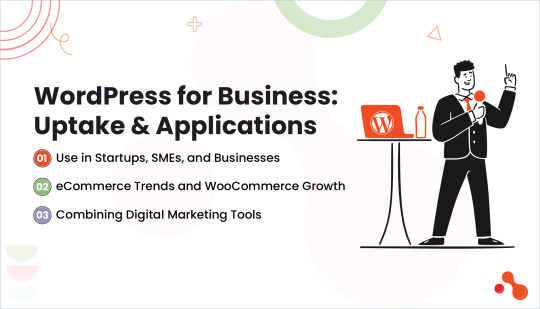
WordPress is still the best option for companies of all sizes in 2025. Because of its extensive plugin support, flexibility, and low setup costs, startups and SMEs are still using it. Bigger businesses are also spending money on customized builds, frequently utilizing them as a content layer for platforms with a lot of traffic or as a headless CMS.
Use in Startups, SMEs, and Businesses
For MVPs, content-driven websites, and quick deployment, startups favor WordPress. It is used by many small and medium-sized businesses for complete websites that have integrated CRM and marketing tools. Enterprise adoption is increasing in media, publishing, and education, where multilingual support and content workflows are critical.
A WordPress website development company frequently supports this growth by providing customized solutions that meet various business sizes and technical needs.
eCommerce Trends and WooCommerce Growth
More than 43% of all eCommerce websites worldwide are powered by WooCommerce. WordPress adoption is still increasing, particularly among regional brands, service providers, and small retailers, according to 2025 statistics. Faster checkout times, multi-vendor support, and mobile-first shopping are becoming more and more important.
Combining Digital Marketing Tools
Deeper integration with digital marketing platforms is now a part of WordPress website design and development. Popular plugins are directly integrated with tools like Google Analytics 4, HubSpot, and Mailchimp to facilitate A/B testing, lead generation, and tracking. These features give companies complete control over their websites while streamlining their marketing.
Community & Ecosystem Growth
More than 18,000 people are actively contributing to WordPress as of 2025, covering code, documentation, translation, accessibility, and support. Through Make WordPress teams, these people work together to enhance everything from editorial tools to performance. Contributions are made by teams, individuals, and freelancers working for all of the major WordPress website development companies worldwide.
Things Like Meetups and WordCamps
Local meetups and WordCamps are back in full force. In 2025, over 120 WordCamps are planned worldwide, with both hybrid and in-person formats becoming more and more popular. Onboarding new developers, educating agencies, and exhibiting advancements in WordPress website design and development are all made possible by community-led events. Local networking and candid conversations are still facilitated by smaller gatherings!
The Open-Source Culture's Effect
WordPress's greatest strength is still its open-source architecture. It promotes openness, information exchange, and quick iterations. WordPress allows users complete control over their code and content, in contrast to closed platforms. A thriving ecosystem of theme developers, plugin authors, and entrepreneurs who depend on a robust yet free foundation to construct their goods and services is supported by this structure.
Top Trends in WordPress Website Development
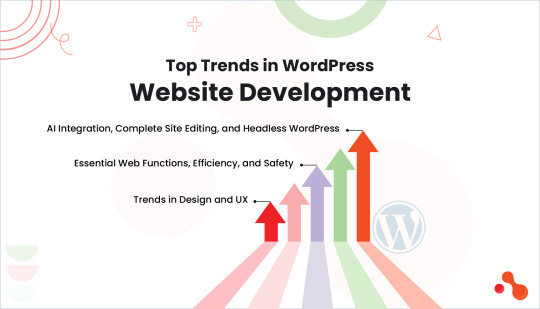
WordPress website development 2025 is influenced by performance, flexibility, and contemporary tools, like:
AI Integration, Complete Site Editing, and Headless WordPress
With the majority of themes supporting global styles and block-based design, full site editing is now a standard feature. AI tools are starting to appear in plugins to help with SEO, layout recommendations, and content. Adoption of headless WordPress is growing, particularly for enterprise and performance-focused projects that use Next.js and other frameworks.
Essential Web Functions, Efficiency, and Safety
Plugins and themes now automatically conform to Core Web Vitals standards. Common objectives include cleaner scripts, faster load times, and better mobile user experience. These days, security tools provide smooth updates, real-time monitoring, and automated hardening. These elements are essential to any contemporary WordPress website development company.
Trends in Design and UX
In 2025, design will prioritize clear visual hierarchy, mobile-first architecture, and simple layouts. Design coherence between blocks is maintained with the aid of tools such as theme.json. Global styling and reusable block patterns speed up the WordPress website design and development process.
Bottomline
With over 43% of the internet running on WordPress and over 62% of the market share among content-managed sites, the platform's continued dominance in the CMS space is confirmed by the WordPress statistics 2025. Its adaptability, extensive ecosystem of plugins and themes, and robust community support have all contributed to its continued success.
Areas like WooCommerce, Full Site Editing, and headless WordPress have all experienced steady growth. While emerging trends in AI, mobile optimization, and performance standards are influencing the next wave of WordPress website design and development, developers and businesses still rely on reliable tools.
In the future, WordPress is probably going to prioritize better support for multilingual and enterprise requirements, quicker editing experiences, and deeper integration with contemporary technologies. With a track record of growth and adaptability, the platform continues to be a viable option for users, agencies, and any WordPress website development company!
0 notes
Text
Hiring Remote Developers for Startups: Mistakes Founders Make in 2025
Introduction
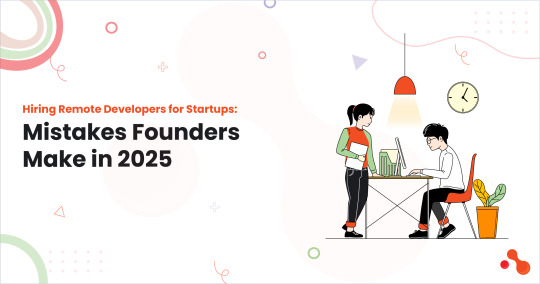
The developer looked perfect on paper. But three weeks later, your sprint backlog hasn’t moved. Somewhere between onboarding and output, momentum breaks. This is the silent failure many founders face when hiring remote developers for startups!
Remote hiring isn’t broken, it’s misunderstood. Founders treat it like a shortcut. In reality, it’s a system that demands planning, structure, and smart evaluation. This blog unpacks the most common remote developer hiring mistakes. You’ll see where startups go wrong, what to watch for, and how to course-correct before it costs time or trust!
Why Startups Prefer Remote Developers in 2025?
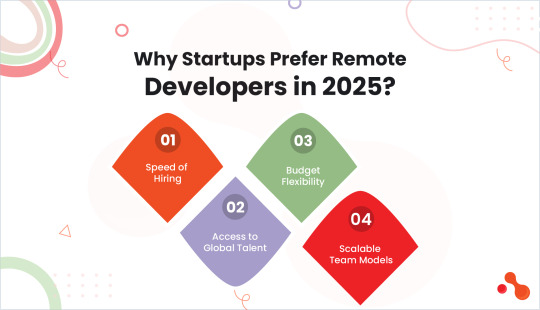
Startups today face constant pressure to ship fast, build lean, and adapt on demand. That’s why many are hiring remote developers as their default development model.
Speed of Hiring
Traditional hiring takes months, whereas remote hiring through vetted platforms or partners can take days, only days. Startups need product velocity, but not recruitment delays!
Access to Global Talent
Founders are no longer limited to local talent pools. Remote hiring unlocks developers across regions, time zones, and tech stacks. This helps startups match niche skills like DevOps, API design, or React Native, on demand.
Budget Flexibility
Hiring full-time employees includes salaries, equity, and overhead. Remote hiring lets founders control burn rate with flexible contracts, hourly billing, or part-time capacity. This matters most in early-stage builds, where every dollar must contribute to product delivery.
Scalable Team Models
Remote developers fit into scalable engagement models. These models give founders flexibility to expand or reduce capacity as product needs change.
Startups can use:
Staff augmentation for short-term needs
Dedicated developer models for long-term build cycles
Hybrid setups of outsource remote developers and in-house team to balance leadership with outsourced execution
Common Mistakes Founders Make For Remote Hiring
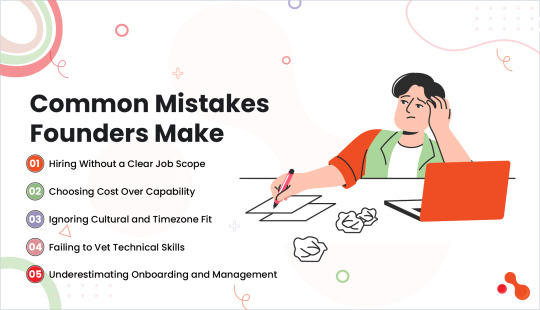
Startup founders often dive into hiring remote developers without a strong hiring strategy. The urgency to build fast sometimes overrides the need for structured evaluation, onboarding, and collaboration planning.
Here are the most common mistakes and how they hurt your product velocity and code quality
Hiring Without a Clear Job Scope
Many founders post generic job briefs like “Need a backend developer for MVP.” This lack of detail results in mismatched hires who either underdeliver or waste cycles asking basic questions. Without clear responsibilities, timelines, and technical requirements, developers can’t align their output with sprint goals.
Tip: Always write a job scope that defines the project stage, stack, tech challenges, and what success looks like after 30, 60, and 90 days.
Choosing Cost Over Capability
It’s tempting to hire the cheapest developer to save early-stage cash. But low hourly rates often come with slower output, incomplete documentation, and messy code that needs refactoring later.
In 2025, realistic hourly ranges look like this:
Mid-level developer (India, Philippines): $15–$25/hr
Senior backend developer (Eastern Europe): $30–$60/hr
Specialists (DevOps, AI, Security): $50–$90/hr
Paying more for developers who deliver right the first time protects your runway and reputation. That's why hiring remote developers with expertise becomes important!
Ignoring Cultural and Timezone Fit
Founders often overlook timezone overlap and communication habits when building remote teams. But when developers work on opposite hours, daily standups fail, questions pile up, and blockers stay unresolved for days.
Tools like Slack, Jira, Loom, and Notion can support async collaboration. Still, a minimum of 4 hours daily overlap improves sprint feedback loops, code reviews, and planning calls.
Failing to Vet Technical Skills
Skipping code tests, portfolio reviews, or trial tasks is one of the biggest remote developer hiring mistakes. A great resume doesn’t always translate to great output under real deadlines.
Founders should assign trial tasks that mirror their actual tech use cases. A two-hour paid test or live coding session can reveal how well a developer handles pressure, code structure, and communication.
Underestimating Onboarding and Management
Even a great hire will fail if the onboarding is poor. When founders drop developers into Slack with no documentation, no product walkthrough, and no tool access, productivity stalls.
What to do?
Create a 1-page onboarding guide with your tech stack, repo access, sprint rules, and expected deliverables. Schedule the first sprint planning call before day one!
Real Startup Scenarios That Went Wrong
At core, remote developer hiring mistakes are about planning, process, and execution. Even with the best intentions, startups often suffer from poor execution when hiring remote developers.
These quick case snapshots show how small hiring mistakes spiral into real product risks.
Case Study 1: The Cheap Hire That Broke the Budget
A seed-stage SaaS startup hired a $12/hour backend developer from a freelance marketplace. The founder skipped technical vetting to save time, assuming the developer’s resume and past client ratings were enough.
Within four weeks, the platform was buggy. Login sessions crashed. The database schema lacked basic normalization. Their QA process exposed over 60 functional issues. A senior Laravel consultant was brought in to rebuild core modules.
In the end, the company spent 2.3x more fixing and re-coding than they would have by hiring a vetted mid-level developer at $25/hour from the start.
Case Study 2: Timezone Misalignment Killed a Launch
An eLearning startup hired two remote developers from opposite time zones one in Vietnam, one in Canada. Neither had more than 1 hour of overlap with the founder in Europe.
As feature testing dragged across three time windows, issues went unresolved for days. One major bug, flagged during staging, went untouched for 48 hours. It caused the platform to break during a live investor demo.
The team missed their planned launch window by three weeks. Investor follow-up cooled, and the founder was forced to rebuild investor trust.
The lesson? Timezone fit and availability matter just as much as technical skill.
How to Avoid These Mistakes The Pro Tips!
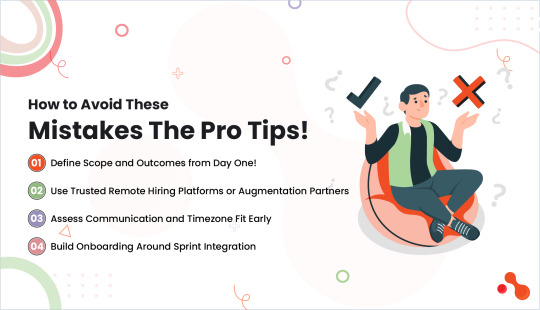
Most mistakes made when hiring remote developers can be prevented with a clear plan and structured process. Below are essential steps every founder should follow before adding a remote developer to their team.
Define Scope and Outcomes from Day One!
Start by writing down exactly what success looks like for the role. Define the project stage, current bottlenecks, expected deliverables, and timeline goals.
Avoid vague tasks like “optimize backend” or “fix speed.” Instead, set targets like “reduce API response time under 200ms” or “deliver mobile-first checkout flow by sprint two.” Clear scopes attract aligned developers and eliminate guesswork during execution.
Use Trusted Remote Hiring Platforms or Augmentation Partners
Working with a developer augmentation partner also gives you access to specialists, DevOps, and QA support when needed. Instead of relying on unverified freelance portals, choose platforms or firms that specialize in hiring remote developers for startups.
Look for services that:
Pre-vet developers with technical and communication assessments
Offer trial periods and replacement policies
Support timezone-matched hiring and sprint-ready onboarding
Assess Communication and Timezone Fit Early
A great developer who can’t collaborate is still a bad hire. During interviews, interviewers must test communication clarity and ask them how they report progress, handle blockers, or manage async workflows. Ensure at least 3–4 hours of overlap for daily collaboration.
Build Onboarding Around Sprint Integration
Onboarding should not just be about access. It must guide the developer into your workflow. Also, define how pull requests, standups, and retrospectives work. It helps new developers become productive within the first week, not the fourth.
Create simple documentation that explains:
Tools and repos
Coding guidelines
Communication preferences
Sprint cadence and planning structure
Why Acquaint Softtech Can Help You Get It Right?
When hiring remote developers, finding the right talent is only half the battle. The rest comes down to speed, communication, and fit. Founders who choose Acquaint reduce delays, avoid hiring guesswork, and scale confidently with people who know how to ship production-grade code.
At Acquaint Softtech, we simplify this process for startups by offering vetted developers who are project-ready in just 48 hours. Our team includes Laravel-certified engineers and official partners with platforms like Statamic and Bagisto, ensuring your backend performance and CMS strategy are built on strong foundations.
We focus on aligning timezone, communication, and delivery culture with your internal workflow. Every developer match includes proper onboarding support, sprint-readiness, and quality assurance coverage.
Bottomline
Too many startups sabotage their growth by rushing into hiring remote developers without structure. Founders often skip job scoping, ignore communication fit, undervalue onboarding, and cost to hire developers, instead of capability. These mistakes multiply your time and money loss in the long run!
Remote hiring can be your biggest growth enabler when done right. It offers flexibility, scalability, and access to world-class talent. But the outcome depends entirely on how you plan, vet, and integrate those developers into your workflow.
Avoid costly hiring mistakes. Start with the right remote team today!
FAQs
What is the best way to hire remote developers for startups?
The best way to hire remote developers for startups is to define your project scope, use trusted hiring platforms or augmentation partners, and assess candidates through technical tests and communication checks. Look for timezone overlap, trial periods, and sprint-readiness from day one.
How much do remote developers cost in 2025?
In 2025, the cost to hire remote developers varies by region and skill level. On average, startups pay $15–$30 per hour for mid-level developers from regions like India or Eastern Europe, while US-based developers can range between $60–$120 per hour. Always weigh cost against communication, quality, and reliability.
What are the signs of a bad remote hire?
Poor communication, missed standups, unclear updates, and lack of proactive feedback are strong signs of a bad remote hire. Others include delivery delays, ignoring coding standards, and failing to integrate into sprint cycles. If trust, output, or responsiveness drops early, consider a replacement immediately.
Should startups hire freelancers or dedicated remote developers?
Freelancers work well for quick fixes or short-term tasks. But for scalable product development, dedicated remote developers offer better reliability, onboarding, and long-term output. Startups aiming for consistent velocity and technical ownership should always choose dedicated hires over one-off freelancers.
Original Source: https://medium.com/@mukesh.ram/hiring-remote-developers-for-startups-mistakes-founders-make-in-2025-fb9609546b54
#Hiring Remote Developers#Startups#Hiring Developers#Hiring Platforms#Remote Team#Hire Remote Team#Hiring Mistakes
0 notes
Text
Empowering Businesses Through Technology: The Strategic Role of IT Staff Services
Introduction
While companies are eager to embrace cloud, AI, automation, and modern development frameworks, they struggle to find the right in-house resources quickly enough. This is where IT Staff Services steps in!
By offering access to pre-vetted, role-ready professionals, these services help organizations maintain momentum, meet deadlines, and align their tech stack with evolving business goals.
Whether it's hiring remote Laravel developers for a SaaS MVP or assembling a DevOps squad to modernize legacy systems, IT staff services provide the right support model for scalable and sustainable digital growth.
What Are IT Staff Services?
IT Staff Services refers to a flexible hiring model that allows businesses to access skilled technology professionals without going through the traditional long-term hiring process. These services support various engagement types including full-time, part-time, project-based, and contract-based roles.
Instead of building internal teams from scratch, companies can quickly onboard remote experts to fill critical skill gaps. For instance, a startup building a web application might hire Laravel developers for backend development, bring in DevOps specialists for cloud deployment, or contract QA engineers to ensure product stability before launch.
Why Modern Businesses Need IT Staff Services?
Modern businesses operate in a rapidly evolving digital environment where technology advances at a breakneck speed. This creates an urgent need for specialized technical skills that in-house teams may not always possess or acquire quickly enough.
Rapid tech innovation needs specialized skills
Emerging technologies like AI, cloud-native systems, and modern frameworks such as Laravel and React require professionals with hands-on experience. IT Staff Services helps fill these gaps by offering access to specialists who are already trained and project-ready.
Cost of wrong or delayed hiring is too high
A wrong hire or extended vacancy in a key technical role can derail product timelines and increase costs. IT staffing solutions reduce this risk by allowing businesses to scale teams with vetted professionals who can contribute from day one.
Need for faster product launches and MVP iterations
Startups and product companies cannot afford to delay releases. With IT staff augmentation for startups, teams can quickly onboard developers or QA experts to support MVP builds, feature rollouts, or even last-minute sprints.
Key Benefits of IT Staff Services for Scaling Companies
As companies grow, resource needs shift rapidly. IT Staff Services offers the adaptability and expertise required to meet those demands without overextending internal teams.
Flexibility to expand or contract based on project phases
Projects often move through different stages: Ideation, Development, Testing, and Scaling.
With flexible tech hiring models, businesses can bring in skilled professionals when needed and scale down when the demand reduces. This avoids the long-term burden of full-time staffing.
Access to a broader, global talent pool
With the help of the best IT staffing companies in 2025, companies are no longer limited to hiring within their region. Whether you want to hire remote Laravel developers or DevOps experts, staff services help tap into a global network of vetted professionals.
Reduced operational overhead and risk
IT staff augmentation eliminates the need to invest heavily in infrastructure, employee benefits, or long onboarding cycles. It also reduces the risk of project delays due to unfilled positions or skill mismatches.
Specialized expertise without full-time commitment
Not every project requires a permanent hire. IT staff augmentation for startups and enterprises allows companies to access specific skills, such as cybersecurity, mobile development, or QA, only for the duration they are needed. This leads to better cost control and resource allocation.
How IT Staff Services Drive Digital Transformation?
Digital transformation requires rapid adaptation to emerging technologies, and IT Staff Services provides the technical agility businesses need to stay ahead in 2025.
Enable faster cloud migrations, app modernization, and AI integration
As businesses shift to the cloud and adopt technologies like AI and machine learning, they need skilled professionals who understand modern infrastructure. IT staffing solutions give companies access to experts who can handle complex transitions, from legacy system upgrades to AI-based automation.
Support DevOps adoption and Agile development
DevOps and Agile practices demand a high level of collaboration and iteration. With dedicated remote developers onboarded quickly, organizations can create reliable CI/CD pipelines, reduce deployment times, and improve team velocity.
Help startups pivot quickly based on market feedback
Startups often need to make product adjustments based on user behavior and changing market dynamics. Flexible tech hiring models allow them to onboard new specialists or restructure their teams without delay, helping them stay lean and responsive.
Types of IT Staff Services You Can Leverage
Businesses in 2025 have access to a range of IT Staff Services that align with their specific project goals, timelines, and budgets. These models provide the flexibility to hire on demand based on immediate or strategic business needs without long-term commitments.
Here’s a breakdown of the most common models and how they’re used in real scenarios:TypeDescriptionExampleAugmentation Add skilled resources to your existing team to fill capability gaps or meet deadlines. Hiring a Laravel developer to support a fast MVP sprint. Dedicated Teams Deploy complete agile squads ready for long-term, full-cycle development. A full-stack remote team to build and scale a SaaS product. Project-Based Staffing Allocate experts for specific deliverables with a fixed project duration. A 6-month eCommerce application developed end-to-end.
Common Challenges IT Staff Services Solve
Businesses often face a range of operational and technical hurdles when scaling. IT Staff Services help resolve some of the most pressing challenges:
In-House Team Burnout
As internal teams juggle multiple projects, deadlines, and support requests, burnout becomes inevitable. IT staffing helps offload tasks by adding external experts who can immediately support key workloads.
Tech Talent Shortage
Finding specialized talent for roles like Laravel development, AI engineering, or DevOps can delay projects. Staff services provide access to vetted professionals across global markets to fill gaps faster.
Faster Market Entry for New Products
Launch timelines often get extended due to resource limitations. With flexible staff augmentation, startups and enterprises can push MVPs or new features to production on time.
Specialized Technology Adoption
Emerging tech such as blockchain, AI, or serverless computing requires niche expertise. Staff services enable businesses to adopt these technologies without hiring full-time specialists.
Choosing the Right IT Staffing Partner: What to Look For?
Selecting the right partner for IT Staff Services is crucial to ensure productivity, reliability, and business growth. Here are the key traits to prioritize:
Certified Developers and Proven Experience
Look for companies with a track record of placing qualified developers, such as Laravel engineers, DevOps specialists, or QA testers. Technical certifications and successful case studies are strong indicators of capability.
48-Hour Onboarding Capabilities
Speed matters when your business needs to move quickly. The right staffing partner should offer fast turnaround times, ideally onboarding remote talent within 48 hours of project approval.
Sprint Planning and Agile Best Practices
Agile integration is vital for modern product teams. Ensure the staffing company can provide talent experienced in Agile workflows, sprint estimation, and iterative development cycles.
Transparent Pricing and Communication Processes
Clear contracts, defined engagement models, and proactive reporting are essential. A reliable partner will maintain ongoing visibility through tools like Jira, Slack, or Asana and offer pricing without hidden costs.
Real-World Success Stories: How Businesses Gained with Staff Services
Many scaling businesses across industries are actively leveraging IT Staff Services to meet growing demands, fill critical skill gaps, and accelerate delivery. Here are some real-world scenarios showing the practical benefits:
✅ Startup Scaling with IT Staff Augmentation for Startups
A healthtech startup in India needed to fast-track their MVP but lacked Laravel and QA expertise internally. By using IT staff augmentation for startups, they onboarded a dedicated remote team in 48 hours, including Laravel developers and testers. The result was a fully functioning MVP within 10 weeks, cutting development time by 40%.
✅ Mid-Sized SaaS Company Using Flexible Tech Hiring Models
A US-based SaaS product company turned to flexible tech hiring models to expand its backend capabilities without long-term hiring commitments. Through a top IT staffing solutions provider, they added DevOps engineers and AI experts for a 6-month sprint, improving performance and scalability.
✅ Ecommerce Enterprise Partnering with the Best IT Staffing Companies 2025
One of Europe’s leading e-commerce platforms modernized its outdated system using one of the best IT staffing companies in 2025. They hired remote Laravel developers and cloud architects to migrate their legacy app to a scalable Laravel-Vue-based system with automated deployments. This move helped improve uptime by 99.95%.
✅ Agency Hiring Dedicated Remote Developers for Client Projects
A digital agency in the UK needed to hire dedicated remote developers to handle seasonal workload spikes. Instead of building a full-time team, they used project-based IT staff services to onboard frontend specialists and WordPress developers. This ensured timely project delivery without increasing fixed payroll costs.
Bottomline
IT Staff Services offer a practical and efficient solution. Whether it's scaling teams for a new product launch, hiring remote Laravel developers, or adopting cloud and AI capabilities without full-time overhead, this model enables lean yet powerful delivery.
From IT staff augmentation for startups to flexible tech hiring models for enterprises, the benefits are measurable. Faster releases, stronger teams, and reduced costs are just the beginning. Businesses that embrace the right IT staffing solutions today are better positioned for growth, innovation, and operational resilience tomorrow. Now is the time to rethink hiring, unlock on-demand expertise, and scale with confidence!
#what are IT staff services#benefits of IT staff services#hire remote Laravel developers#best IT staff services company
0 notes
Text
The Ultimate WordPress Security Checklist to Safeguard Your Website

WordPress security has become a top priority in 2025 as the platform now powers over 40% of all websites globally. Its popularity has made it a leading target for cyber threats, from brute-force login attempts to plugin vulnerabilities.
According to Hostinger, WordPress websites account for nearly 90% of all CMS-based attacks. MalCare also reports that many successful breaches happen due to weak passwords, outdated themes, and inactive plugins.
This checklist outlines essential practices, tools, and configurations to help secure your site. Whether you're using WordPress security plugins, relying on secure WordPress hosting, or working with a WordPress website development company, these steps will help reduce risk and strengthen protection.
Core Security Basics: Protect Your Foundation

Strong WordPress security starts with the fundamentals. Ignoring the basics can expose your website to unnecessary risk. These basic steps create the foundation for a well-protected site and should be followed by every WordPress website development company or site owner.
Use Strong Passwords Everywhere
Always use complex passwords for admin logins, hosting accounts, FTP, and database access. Avoid using the same password across services.
Keep WordPress Core, Themes, and Plugins Updated
Regular updates ensure your site runs on the latest, most secure codebase. Outdated plugins and themes are common entry points for attackers.
Choose Secure WordPress Hosting
A secure hosting provider with firewall protection, malware scanning, and daily backups strengthens your website’s security posture. Reliable, secure WordPress hosting is critical to reduce server-side threats.
Limit Admin Access
Assign admin rights only to essential team members. Use roles wisely and disable unused accounts.
User and Access Control: Limit Vulnerabilities

Effective access control is a foundational part of WordPress security. It helps ensure only trusted users interact with sensitive parts of your site. The checklist towards success involves:
Enable Two-Factor Authentication (2FA)
Two-factor authentication adds a second layer of identity verification during login. It protects against credential leaks and minimizes unauthorized access attempts.
Set Proper User Roles
Assign users only the access they need to perform their tasks. This limits unnecessary backend exposure and maintains tighter control over your WordPress website.
Limit Login Attempts
Restricting the number of login tries defends against brute-force attacks. Many WordPress security plugins offer this feature with customizable lockout rules.
Avoid Using the Default “admin” Username
Using a unique username for the administrator reduces the chance of being targeted in automated attacks. It is a basic step but often ignored.
Review User Access Regularly
Conduct audits of user roles and access every few months. Removing old accounts or resetting permissions helps maintain long-term security hygiene.
Plugin and Theme Safety: Choose Wisely

Themes and plugins are powerful but often exploited. To maintain strong WordPress security, it's critical to vet and manage them properly. Here are the best practices you can adopt:
Install Only Trusted Plugins and Themes
Use plugins and themes from reputable sources with high ratings and recent updates. Avoid nulled or pirated software as they often contain malware. Trusted options reduce security risks.
Keep Everything Updated
Outdated plugins and themes can become entry points for attackers. Regular updates close known security gaps and keep your WordPress website resilient against emerging threats.
Remove Unused Plugins and Themes
Even inactive plugins can introduce vulnerabilities. Delete anything you’re not actively using to minimize your site’s exposure.
Use Plugins with Active Maintenance
Choose plugins that are actively supported and regularly patched. A well-maintained plugin contributes to long-term WordPress security and performance stability.
Monitor for Plugin Vulnerabilities
Use the latest WordPress development tools or WordPress security plugins that scan for known plugin and theme risks. Set alerts to catch issues before they become threats.
Website Hardening: Advanced Protection Measures
For a truly secure site, you need to go beyond basic settings. Website hardening focuses on tightening system-level defenses to strengthen your overall WordPress security posture.
Install and Renew SSL Certificates
Secure Sockets Layer (SSL) encrypts data transmitted between users and your website. Make sure your SSL is properly installed and renewed to maintain HTTPS. It's also a basic trust factor for visitors.
Set Correct File Permissions
Improper file permissions can allow unauthorized access. Use 644 for files and 755 for folders to restrict direct modification. This reduces the chances of backdoor exploits or unauthorized code changes.
Disable File Editing via WordPress Dashboard
By default, WordPress allows file edits through the admin panel. Disabling this option in wp-config.php prevents attackers from injecting malicious code if admin access is compromised.
Hide WordPress Version
Displaying your WordPress version can help attackers identify vulnerabilities. Use functions or plugins to hide version info from both the frontend and the source code.
Secure wp-config.php and .htaccess Files
These files hold critical configurations and should be read-only. Apply strict file permissions and move wp-config.php one level above the root directory when possible.
Backup and Monitoring: Stay Prepared

No matter how strong your WordPress security measures are, things can still go wrong. Regular backups and active monitoring ensure you’re prepared to recover quickly from any breach or error.
Schedule Regular Backups
Set up automatic daily or weekly backups, stored offsite or on the cloud. Backups should include your entire WordPress database, files, themes, and plugins. This gives you a reliable restore point in case of attacks or failures.
Use Activity Log Monitoring Tools
Monitor changes in your admin dashboard, plugin updates, theme edits, and user logins. Activity logs help detect unauthorized behavior early. Many WordPress security plugins, like WP Activity Log, make this process efficient.
Scan for Malware Frequently
Automated malware scans identify injected code or suspicious scripts. Tools like MalCare and Sucuri detect threats that bypass basic security layers. Early detection helps avoid SEO penalties and data leaks.
Enable Uptime and Downtime Alerts
Real-time site monitoring allows you to know the moment your website goes offline. Alerts help you act quickly before visitors notice or rankings are affected.
Proactive Tools and Services: Enhance Security
Strong WordPress security requires more than just good practices, it demands advanced tools and expert insight. These tools and services create a multi-layered defense system that hardens your WordPress security against modern attacks.
Use Trusted WordPress Security Plugins
Install proven solutions like Wordfence, Sucuri, or iThemes Security. These tools provide firewall protection, malware scanning, login security, and real-time alerts, all essential to a secure WordPress setup.
Configure Web Application Firewalls (WAFs)
Firewalls block malicious traffic before it even reaches your site. Most top-tier WordPress security plugins include WAF features or integrate easily with cloud-based firewalls for added protection.
Schedule Regular Security Audits
Engage a WordPress website development company or use services like WPScan to audit your codebase and configuration. Regular audits help detect vulnerabilities you might miss during routine updates.
Run Vulnerability Scans on Plugins and Themes
Use scanners to check installed plugins and themes for known CVEs. Tools like WPScan or services integrated with secure WordPress hosting providers often automate this process.
Monitor Login and File Change Behavior
Combine your security plugin with a detailed file integrity monitor. If unexpected file changes occur, you’ll be alerted immediately, helping prevent deeper breaches.
Bottomline
WordPress powers more than 40% of websites, which makes strong WordPress security more important than ever. A secure website protects your data, builds user trust, and ensures business continuity.
Start with the basics like using strong passwords, keeping plugins updated, and choosing secure WordPress hosting. Add extra layers of protection with access control, trusted plugins, regular backups, and proactive monitoring. Staying consistent with these practices helps businesses to keep their WordPress website protected and ready for growth in 2025!
0 notes
Text
Why IT Staffing Solutions Are Key to Business Growth in 2025
Introduction
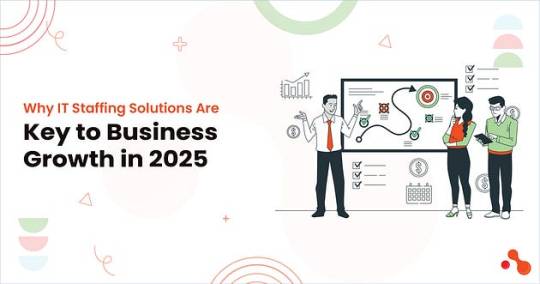
In 2025, the demand for top-tier tech talent continues to outpace supply, making it harder than ever for companies to scale at the speed required. Hiring delays don’t just slow product development, they create lost opportunities and reduced market competitiveness.
For startups and enterprises alike, the solution lies in IT staffing solutions. These models provide a faster, more flexible path to acquiring skilled developers, eliminating the lengthy timelines associated with traditional hiring. Whether you’re trying to reduce time-to-market or fill urgent skill gaps, IT staffing for startups and growing businesses is now a strategic lever for growth.
What Are IT Staffing Solutions?
IT staffing solutions are flexible hiring models that help businesses quickly access skilled developers or technical talent without the long-term commitment of full-time employment. Instead of building permanent in-house teams, companies can bring in remote professionals as needed.
There are several types of IT staffing models:
Staff Augmentation — Add developers to your internal team to fill specific skill gaps or meet tight deadlines.
Dedicated Teams — Hire a dedicated remote team that works exclusively on your product, managed either by you or the staffing partner.
Project-Based Hiring — Get a specialized team for a single project with clear timelines and deliverables.
More startups and enterprises are choosing IT staffing vs. full-time hiring due to cost savings, speed of onboarding, and the ability to scale teams up or down without delays. For companies focused on growth, it’s an efficient and scalable approach to building tech teams without being slowed down by traditional recruitment.
7 Ways IT Staffing Solutions Accelerate Business Growth
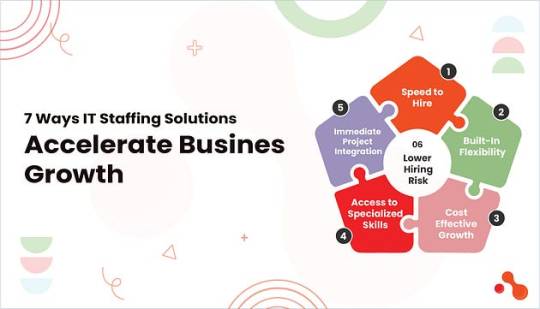
Whether you’re launching an MVP or scaling a SaaS platform, IT staffing solutions offer startup founders and tech leaders a smarter way to build and grow development teams. Here’s how they directly impact your growth trajectory:
1. Speed to Hire
Speed is often the difference between capturing the market and falling behind. Traditional hiring cycles take anywhere from 2 to 4 months, including job posting, interviews, onboarding, and training. In contrast, IT staffing companies offer pre-vetted developers who can join your team within 48–72 hours.
📊 According to the DevSkiller IT Skills Report 2024, organizations leveraging staff augmentation cut hiring times in half and accelerate time-to-product-launch by up to 40%.
2. Built-In Flexibility
One of the core benefits of IT staffing is the ability to scale up or down depending on your sprint load, funding stage, or seasonal traffic demands. You avoid the bloat of over-hiring while still staying agile. This makes IT staffing ideal for fast-growth environments where headcount planning often shifts with market dynamics or release cycles.
3. Cost-Effective Growth
The true cost of full-time hiring goes beyond salaries. You also pay for recruitment, benefits, hardware, office space, and long-term HR commitments. With IT staffing solutions, these overheads are minimized. You pay only for productive hours, which improves ROI across the board.
According to Statista, 70% of companies cited cost reduction as the primary reason for outsourcing IT functions, showing how staffing solutions help businesses scale affordably in global markets.
4. Access to Specialized Skills
Finding senior developers with niche expertise (e.g., Laravel, DevOps, AI, or Cloud) is not only time-consuming but also expensive in competitive markets. IT staffing gives you immediate access to talent pools that have already been assessed and matched to your stack.
Whether you want to hire Laravel developers or build a DevOps team for cloud migration, the specialized developer pool offered by staffing firms ensures that you’re never stuck waiting for the right hire.
5. Immediate Project Integration
One of the most underrated advantages of IT staffing for startups is how quickly developers integrate into your product lifecycle. Unlike freelancers, who often lack alignment with your roadmap, staffing partners provide dedicated developers who work under your tools, time zone, and team processes.
They’re ready to contribute in agile environments, participate in standups, and deliver sprint goals from day one. This seamless onboarding saves valuable time during product sprints.
6. Lower Hiring Risk
Hiring full-time developers means investing time, money, and training, only to realize months later that they aren’t the right fit. IT staffing solutions reduce this risk. You can start with a short-term contract, assess performance, and extend only if there’s alignment. Plus, if a developer doesn’t work out, a reliable IT staffing partner replaces them quickly without slowing down your roadmap.
7. Global Talent Access
Limiting your hiring to a single location shrinks your access to great talent. With IT staffing, you can hire remote developers globally, enabling 24/7 development cycles, faster resolution times, and improved delivery speeds.
You also gain access to IT staffing companies in India, Latin America, and Eastern Europe, regions known for high technical proficiency and cost-efficiency. This global reach is essential in 2025, where demand often outpaces local supply.
Real-Life Business Scenarios: Where IT Staffing Solutions Shine
IT staffing solutions are not merely a contingency plan; they serve as a strategic asset across various business stages. Below are four scenarios illustrating how businesses have effectively leveraged flexible staffing models to achieve growth.
1. Startup Building MVPs with Lean Budgets
Startups often operate under tight financial constraints and need to validate their products swiftly. Traditional hiring processes can be time-consuming and costly. By utilizing IT staffing solutions, startups can access skilled developers rapidly, enabling them to build and launch Minimum Viable Products (MVPs) efficiently.
2. Mid-Sized SaaS Company Expanding Product Features
As SaaS companies grow, the demand for new features and integrations increases. Scaling internal teams quickly to meet these demands can be challenging. IT staffing solutions provide the flexibility to bring in specialized talent, such as Laravel or React developers, to accelerate development cycles without the long-term commitment of full-time hires.
3. Enterprise Migrating Legacy Systems to Modern Stacks
Enterprises aiming to modernize legacy systems require niche skills in areas like DevOps, cloud migration, or AI integration. Hiring full-time experts for these short-term projects may not be cost-effective. IT staffing solutions enable enterprises to access specialized skills on demand, ensuring smooth transitions without the overhead of permanent hires.
4. Mini Case Example: Acquaint Softtech Healthtech Client
A healthtech startup in the U.S. sought rapid scaling after securing Series A funding. Instead of establishing a new office, they partnered with Acquaint Softtech to hire dedicated remote developers. Within six months, their development team expanded by 300%, facilitating new feature rollouts, HIPAA-compliant integrations, and improved deployment speeds.
This strategic move allowed the startup to meet product milestones, attract enterprise clients, and enter new markets while maintaining predictable hiring costs.
IT Staffing vs Traditional Hiring: Why Staffing Wins for Growth

Common Mistakes When Choosing IT Staffing Solutions (And How to Avoid Them)

With IT staffing, you must choose the right IT staffing solutions as well. But without proper planning, companies risk delays, mismatched talent, and wasted budgets. Avoid these common mistakes to ensure your staffing strategy delivers results.
1. Focusing Only on Price Over Quality
Many companies prioritize cheap rates, but this often leads to underqualified developers and unstable outcomes. A low-cost approach without quality checks usually results in hidden expenses later.
✅ Solution:
Focus on long-term value, not just pricing. Choose partners that offer access to hire remote developers with verified expertise and strong project portfolios.
2. Partnering with Firms That Lack Certifications
Some providers skip basic compliance or security certifications, putting your systems and data at risk. This becomes a major concern when working in regulated industries.
✅ Solution:
Work with an IT staffing company in India or globally that holds certifications like ISO 27001 and demonstrates strong data protection standards.
3. Undefined Project Scope and Requirements
If the scope is unclear or requirements are vague, delivery often suffers. Developers may build features that don’t meet business needs or miss key milestones.
✅ Solution:
Use tools like Jira to plan deliverables, clarify responsibilities, and align your IT staffing solutions with internal goals.
4. No Communication Playbook
Without a defined communication process, remote teams operate in silos. This causes delays, confusion, and wasted effort across teams.
✅ Solution:
Whether you hire dedicated developers or scale through staff augmentation, always define meeting cadences, tools, and reporting workflows.
How to Choose the Right IT Staffing Partner for Growth?
Finding the right IT staffing partner can define how quickly and effectively your business scales. These are the essentials to look for:
✅ Proven Experience and Certifications
Choose a provider with a strong portfolio and certifications like ISO 27001 or GDPR compliance. This ensures reliable delivery and data security.
✅ Fast Onboarding Process (Within 48 Hours)
The ability to hire remote developers quickly helps meet urgent product timelines and prevents delays in your sprints.
✅ Transparent Contracts and Replacement Guarantees
Work with partners that offer clear terms, NDA protection, and free developer replacement to reduce your hiring risk.
✅ Strong Client Success Case Studies
Look for real-world results that prove their ability to deliver. Verified case studies from SaaS companies or startups add trust.
Future of IT Staffing: More Critical Than Ever for Scaling

The future of IT staffing solutions is driven by speed, flexibility, and evolving technologies. Businesses aiming to scale efficiently must stay ahead of these trends:
✅ Growth of AI-Driven Staffing Platforms
Advanced platforms are now matching companies with vetted developers faster using AI, reducing manual hiring bottlenecks.
✅ Hybrid Models Gaining Popularity
Many firms are blending remote development teams with local hires to balance flexibility with on-site collaboration when needed.
✅ Future-Proofing with Flexible Staffing
To scale sustainably, startups and growth-stage companies are relying on IT staffing for startups and growth-stage companies to adapt quickly as priorities shift.
Bottomline
In today’s fast-moving digital economy, IT staffing solutions give startups and enterprises a clear edge. From accelerating product development to accessing specialized skills quickly, the benefits of IT staffing go beyond just saving costs. Compared to traditional full-time hiring, it offers unmatched scalability, speed, and access to global tech talent without the delays or overhead.
Whether you’re aiming to hire Laravel developers, scale a remote squad, or tap into the benefits of IT staffing for niche tech roles, the flexibility it brings is unmatched. With market demands evolving rapidly in 2025, sticking to outdated hiring models may slow your momentum.
Now is the time to adopt smarter hiring strategies that align with growth. Choosing the right IT staffing company in India or globally can help you stay ahead, scale faster, and deliver more without compromising quality.
#business growth with IT staffing#hire Laravel developers#choosing IT staffing partner#how IT staffing helps business
0 notes
Text
Security Tips When Working With Remote Development Teams in 2025
Introduction

The landscape of software development has fundamentally shifted. For CTOs and startups seeking agile, cost-effective solutions, engaging remote development teams, particularly outsourced ones, has become a strategic imperative.
This global talent pool offers unparalleled flexibility and access to specialized skills. However, this distributed model also introduces a complex array of security challenges that demand proactive and sophisticated mitigation strategies.
In 2025, with cyber threats growing in sophistication and regulatory scrutiny intensifying, a robust security posture for remote development is not merely a best practice; it is a critical business enabler.
This article provides CTOs and decision-makers with actionable insights into fortifying their defenses when collaborating with remote development teams.
It explains the importance of focusing on cybersecurity for remote teams and explains how to achieve that.
The Evolving Threat Landscape in 2025

Remote development, by its very nature, expands the attack surface. Traditional perimeter-based security models struggle to contain threats when your developers operate from diverse locations, often using personal networks and devices.
In a remote development model, the attack surface expands. You no longer control the entire network, physical devices, or day-to-day developer environment. Sensitive code, credentials, and third-party dependencies are accessed by contributors who may be working from shared coworking spaces or unsecured home networks.
In a remote development model, the attack surface expands. You no longer control the entire network, physical devices, or day-to-day developer environment. Sensitive code, credentials, and third-party dependencies are accessed by contributors who may be working from shared coworking spaces or unsecured home networks.
Security threats come in various forms:
Credential leaks through shared passwords or unmanaged access
IP theft or misuse of proprietary code
Unpatched systems being used for development
Supply chain attacks via compromised open-source packages
Shadow IT practices like using unauthorized cloud services
Ignoring these threats can result in reputation damage, compliance violations, and severe financial losses.
Remote development security may feel excessive—until the day it’s not enough. In 2025, the smallest oversight can become your biggest risk.
How is Remote Development Security Different?

Expanded Attack Surface:
Every remote endpoint – a laptop, mobile device, or home network – represents a potential entry point for attackers. Without the controlled environment of a corporate office, these endpoints become vulnerable.
Reduced Visibility:
Monitoring network traffic and user behavior across a distributed team presents significant challenges. Detecting anomalous activity becomes harder without centralized logging and real-time insights.
Insider Threat Amplification:
While not unique to remote work, the potential for insider threats – both malicious and accidental – is exacerbated. Disgruntled employees, phishing attempts, or simple human error can have more far-reaching consequences in an environment with less direct oversight.
Supply Chain Vulnerabilities:
When outsourcing, you inherit the security posture of your development partner. Their weaknesses become your weaknesses, creating a complex supply chain of trust that demands rigorous vetting and continuous monitoring.
Evolving Cyber Threats:
The threat landscape is in constant flux. Ransomware, sophisticated phishing campaigns, zero-day exploits, and supply chain attacks are becoming more prevalent and targeted, demanding a proactive and adaptive security strategy.
Top Security Risks
Developing software means dealing with security issues irrespective of how you choose to develop it. However, the security vulnerabilities when working with a remote team are different. In fact, as the threat of cyber attacks grows the security issues also tend to grow. This makes it vital businesses update their security efforts regularly.
Here are some of the top concerns that keep folks up at night when managing remote development:
Freelancers using insecure Wi-Fi networks leave themselves vulnerable to attacks.
Personal devices using outdated software or having outdated security software can spell disaster.
Remote personnel unaware of common attacks like phishing emails, texts, etc can easily fall prey to hackers.
The lack of well-defined and secure tools to communicate or transfer files poses a huge security issue.
Developers resorting to alternative tools for communication or sharing sensitive data when their software is not working is very risky.
Remote development teams tend to delay critical updates or patches to save time leaving their systems vulnerable to attacks.
Mishandling sensitive data during the development process is a cause for concern.
Security Tips to Protect Your Startup or Business

Remote-First Security Policy:
Adopt a remote-first security policy which involves verifying the standards of the devices being used. Ensure all accounts have a two-factor authentication and verify the cloud services being used. Establish rules for handling source code and dependencies as well. Maintain an incident reporting protocol and a policy for emerging threats.
Zero Trust Architecture:
Implement a zero trust architecture by following the below strategy:
Background checks and NDA agreements
Ask for security compliance certifications.
Review their code samples and repositories for remote team security best practices
Include security assessments during technical interviews.
Establish a clear onboarding and offboarding process for access rights.
Use Secure Communication Channels:
The development environment is filled with security vulnerabilities. Ensure you have end-to-end encrypted tools, use encrypted file transfer tools, and avoid sharing credentials over chat or email. Alternatively, use password vaults or something similar. The video platforms being used for communication or code review need to be secure as well. Should also have training to follow secure code practices for remote teams.
Manage Secrets the Right Way:
Never hardcode credentials in source code.
Use secrets management tools.
Never commit secrets to Git; enforce pre-commit hooks to prevent it
Automate secrets rotation using CI/CD workflows.
Store secrets in environment variables at runtime, not in code.
Use short-lived credentials with expiration logic for external services and APIs.
A single leaked API key can compromise entire systems. Automate its protection.
Secure the CI/CD Pipeline
Ensure signed commits and Git commit verification.
Isolate build environments with ephemeral runners.
Scan builds for vulnerabilities using special tools.
Ensure production deployments require manual approval or reviewer signoff.
Monitor Developer Activity
Monitor Git activity for code insertions, deletions, or suspicious patterns.
Set up real-time alerts for unusual access to sensitive repositories or endpoints.
Implement role-based dashboards to review changes, pull requests, and deployments.
Maintain transparency about monitoring setup.
Do not forget the goal is to detect anomalies and not generate mistrust.
Maintain a Shared Security Culture:
Maintain a continuous security mindset by building a strong security culture. Organize regular security workshops, set up shared channels to report security issues, and generate security awareness.
Plan for Incidents in Advance:
Take all the necessary precautions but always have a plan ready to deal with an incident. This can be done by defining the roles and responsibilities of the respective personnel in case of an incident. Document the escalation path for each type of breach and maintain a checklist for isolating compromised systems. Define the internal communication protocol to avoid chaos. Run quarterly security drills to ensure remote team readiness.
A fitting quote -
“A breach alone is not a disaster, but mishandling it is.” – Serene Davis
Evaluate Legal & Compliance Risks:
Account for the legal and regulatory implications in case of a security issue. Failing to comply with cross-border data transfer rules can result in steep penalties. Consult a data privacy expert when structuring remote engagements across borders.
Review and Audit Regularly:
Ensuring security when working with a remote team is not like a one-time setup. It is a mindset and a process that one must proactively implement. Audit codebases for vulnerabilities and secrets, always rotate keys, passwords, and access tokens regularly, and test backups and disaster recovery systems.
How Strong Security Builds Trust and Faster Growth

The threat of cyber attacks is larger than ever in 2025 making it the top priority on everyone's minds. Hence, firms that take all appropriate measures to ensure security tend to be better trusted. It ensures peace of mind besides the high-quality software solution.
Here are a few interesting statistics:
The cost of cybercrime worldwide in 2025 is 9.22 Trillion USD.
There were close to 860,000 complaints of cybercrime registered in 2024 with potential losses exceeding $16 Billion. - FBI Crime Report
There were over 6.5 billion malware attacks worldwide in 2024.
Hence it is best to work with a professorial and well-established software development firm like Acquaint Softtech. Hire secure remote developers that prioritizes security while delivering cutting-edge solutions.
Conclusion
The need for better security is at its peak in 2025 as more businesses choose to outsource their requirements. Hence the obvious questions
Should one rethink outsourcing because of security?
How much does it cost to hire remote developers?
Remote development is a strategic shift, however, without security at its core, that shift becomes a liability. As we move deeper into 2025, startups and CTOs must adapt to an evolving security landscape where distributed teams, global collaborations, and cloud-native development are the norm.
The secret to remaining competitive is to build a secure remote software development culture that aligns across policies, tools, teams, and behaviors. It’s not just about keeping attackers out—it’s about designing systems that are resilient even when things go wrong. For businesses wondering - how to hire developers for startup?
Promote a security-first mindset and build strong relationships. Embrace the security tips explained in this article while outsourcing your software development requirements to a well-trusted firm like Acquaint Softtech.
Doing so will protect your assets but also enhance your reputation and build trust with your clients and stakeholders.
FAQ
How can I ensure secure collaboration with a remote development team?
Use encrypted tools like VPNs and password managers, limit access by roles, and regularly audit activity logs.
Should NDAs still be used in 2025 when working with remote teams?
Absolutely. NDAs and IP protection agreements are essential to safeguard your intellectual property, especially with global teams.
What tools can help improve security in remote development?
GitHub with branch protection, Snyk for code vulnerability scanning, 1Password for credential management, and secure VPNs like NordLayer or Perimeter 81.
What’s the biggest security risk with remote developers?
The biggest risk is unauthorized data access due to poor access control or lack of proper endpoint security protocols.
Original Source: https://medium.com/@mukesh.ram/security-tips-when-working-with-remote-development-teams-in-2025-835c9d667049
0 notes
Text
Agencies vs Freelancers: Who Wins in Mobile-First WordPress Optimization?

In 2025, mobile-first WordPress optimization will become essential for site performance and user retention. A mobile-first design ensures your WordPress site loads fast, adapts to screen sizes, and maintains usability across all devices.
More than 59% of global website traffic comes from mobile devices, making performance optimization a non-negotiable factor. Optimizing a WordPress site for mobile goes beyond responsive design. It includes mobile WordPress speed optimization, asset compression, minimal code render-blocking, and effective caching setups via WordPress development tools.
But who should handle your optimization?
You have two options
agencies with structured workflows or
freelancers with flexible engagement models.
Each approach brings a different perspective to hiring WordPress developers, and each impacts delivery, scalability, and speed in distinct ways. But the real question is:
Which one ensures better results for mobile-first WordPress optimization?
This blog compares both models side by side to help you decide what works best for your WordPress performance goals!
What is Mobile-First WordPress Development?

Mobile-first WordPress development means building the mobile version of your site before the desktop version. It prioritizes loading speed, clean UI, and responsive interactions for smaller screens.
In WordPress, this starts with choosing a responsive theme and optimizing the layout to load critical mobile content first. Developers then enhance performance using techniques like image compression, lazy loading, and asynchronous scripts.
Why does this matter?
Mobile WordPress speed optimization directly affects user engagement and bounce rate. If your mobile site loads in over three seconds, most users leave.
Core Benefits of Mobile-First WordPress Development
Faster load times improve session duration and reduce bounce
Improved SEO performance, since Google prioritizes mobile-first indexing
Better user experience (UX) with simpler navigation and touch-first design
These benefits only work if the technical foundation supports them. That’s where key performance metrics come in.
Key Metrics for Performance Evaluation
LCP (Largest Contentful Paint): Measures how quickly the main content loads
CLS (Cumulative Layout Shift): Tracks how stable the layout remains during load
TTI (Time to Interactive): Gauges how fast a user can engage with content
Mobile PageSpeed Score: Google’s score based on technical and UX performance
Freelancers and agencies approach these metrics differently. The next section will show how.
Why Performance Optimization Matters in Mobile-First?
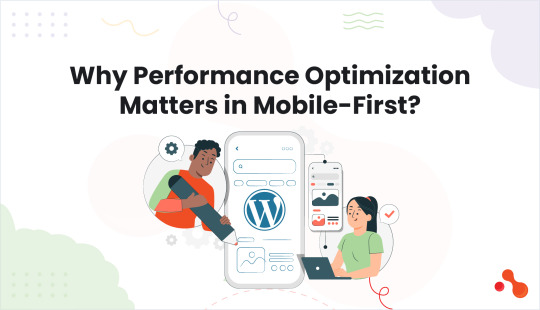
In a mobile-first world, performance optimization drives both visibility and conversions. Google now uses mobile-first indexing by default, meaning it evaluates your site’s mobile version before the desktop version.
If your WordPress site performs poorly on mobile, it won’t rank, regardless of how strong your desktop version looks. This is where mobile-first WordPress optimization makes a measurable difference.
Mobile Performance = SEO Performance
Google’s Core Web Vitals LCP, CLS, and TTI are major ranking factors.
A slow-loading mobile page fails these metrics and drops in search results.
Also, a poor mobile WordPress speed optimization strategy directly impacts the PageSpeed score, which lowers ranking potential further. A trustworthy WordPress website development company would help you solve the complications well!
Mobile Bounce Rates Are Brutal
Studies show that mobile users are 32% more likely to bounce than desktop users when a site is slow or unstable. If your mobile site loads in over three seconds, 53% of users abandon it before interacting.
What Poor Optimization Looks Like on Mobile?
Fonts are too small or hard to tap
Layout shifts while loading
Unoptimized images are slowing the page
Mobile menus failing on tap
Content blocked by interstitials or banners
Delays in response after a click
Whether you hire WordPress developers via an agency or freelance, their ability to handle these issues determines your site's mobile success.
Freelance WordPress Developers: Strengths & Limitations
Freelance WordPress developers offer a flexible and cost-effective solution for businesses aiming to implement mobile-first WordPress optimization. Their adaptability and specialized skills can be particularly beneficial for projects with specific performance goals.
Strengths
Cost-Effective for Small Projects
Freelancers often provide competitive rates, making them suitable for startups and small businesses seeking mobile WordPress speed optimization without extensive budgets.
Direct Communication and Agility
Working directly with a freelancer allows for quick decision-making and rapid implementation of changes, essential for iterative optimization processes.
Specialized Expertise
Many freelancers focus on niche areas. For instance, some specialize in enhancing mobile performance metrics like LCP and TTI, crucial for mobile-first WordPress optimization.
Limitations
Limited QA and Testing Resources
Freelancers may lack access to a wide range of devices and testing tools, potentially impacting the thoroughness of mobile optimization.
Single Point of Failure
Relying on one individual can pose risks if they become unavailable, affecting project continuity.
Potential Lack of Long-Term Support
Some freelancers may not offer ongoing maintenance, which is vital for sustained performance and security.
Real-World Example
A U.S.-based digital agency reduced development costs by 40% by hiring a skilled WordPress developer from India. The freelancer delivered a mobile-optimized site that met the agency's performance standards, demonstrating the potential benefits of this approach.
WordPress Development Agencies: Strengths & Limitations

Partnering with a WordPress development agency can be a strategic move for businesses aiming for mobile-first WordPress optimization. Agencies offer a comprehensive approach, combining diverse expertise to deliver robust and scalable solutions.
Strengths
Team-Based Approach
Agencies bring together frontend and backend developers, QA testers, and SEO specialists. This collaborative environment ensures that every aspect of your WordPress site is optimized for performance and user experience.
Access to Advanced Tools and Device Labs
Agencies often have access to a wide range of devices and testing tools, enabling thorough mobile WordPress speed optimization across various platforms and screen sizes.
Reliability in Handling Complex Projects
For large-scale or intricate projects, agencies provide structured processes and project management, reducing the risk of delays and ensuring consistent quality.
Limitations
Higher Cost
The comprehensive services offered by agencies come at a premium, which may not be feasible for smaller businesses or startups.
Slower Execution Due to Structured Processes
Agencies follow established workflows, which can sometimes lead to longer timelines for project completion.
Less Flexibility for Quick Updates
Making rapid changes or updates can be challenging due to the layered approval processes within agencies.
Real-World Example
Seahawk Media is a white-label WordPress agency that has successfully partnered with over 1,000 brands, including Alibaba. They specialize in delivering high-performance WordPress websites, offering services like custom theme development, plugin integration, and site speed optimization. Their structured approach ensures consistent quality and scalability for clients.
Comparison Table: Freelancers vs Agencies for Mobile-First Performance
When planning mobile-first WordPress optimization, businesses often compare freelancers with agencies based on delivery speed, cost, and scalability. Whether you aim to hire WordPress developers or partner with WordPress experts for hire, this comparison below helps set realistic expectations for mobile-first delivery.

Freelancers may excel in mobile WordPress speed optimization when the task is niche and lightweight. However, agencies ensure a complete performance cycle from testing to deployment. It is ideal for high-traffic or growth-driven WordPress projects.
Use Case Scenarios: Who Should Choose What?

Not every project needs a large team, and not every freelancer fits long-term goals. Choosing between WordPress experts for hire and agency partnerships depends on your site's scale, timeline, and technical needs.
Freelancers can help you hire WordPress developers quickly for focused work like mobile-first styling or image optimization.
Choose Freelancers If:
You manage a small WordPress website or personal blog
Your budget is limited, and the project scope is narrow
You need quick performance fixes or one-time mobile WordPress speed optimization
You prefer direct developer communication and fast iterations
Your site doesn’t require long-term maintenance or security layers
Agencies are ideal when performance goals tie into SEO, branding, and long-term reliability.
Choose Agencies If:
You operate a high-traffic WordPress website or a growing SaaS platform
You need ongoing performance monitoring and responsive support
You want a team with QA, DevOps, and SEO working together
Your site handles sensitive user data or eCommerce transactions
You need complete mobile-first WordPress optimization, from audit to delivery
Bottomline
In a mobile-first digital landscape, performance is no longer optional now. A fast-loading, well-optimized WordPress site directly impacts traffic, SEO, and conversions.
Whether you choose an agency or go with WordPress experts for hire, your decision must align with your project’s goals. It’s not about picking the cheaper option. It’s about choosing the right fit, support, and scalability for your mobile-first needs.
Use this simple checklist to make a clear decision:
Decision Checklist
Budget: Can you afford one-time or ongoing optimization support?
Scope: Is it a small update or a full mobile-first rebuild?
Tech Needs: Do you need specialized skills like mobile WordPress speed optimization or cross-device QA?
Timeline: Do you need a quick fix or long-term performance tracking?
Support: Will you need post-launch help and scalable resources?
Choosing the right path helps you hire WordPress developers who deliver speed, structure, and stability where it matters most!
0 notes
Text
7 Ways IT Staff Augmentation is Powering Tech Startups in 2025
Introduction
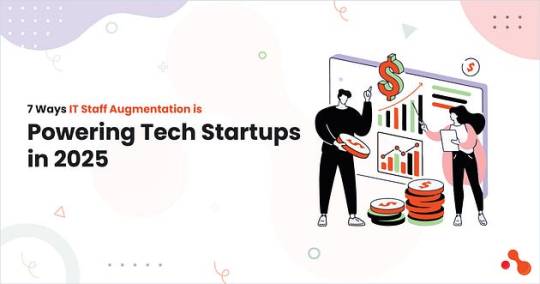
In 2025, every tech startup faces one core challenge: scaling fast without breaking. IT staff augmentation solves that. Startups today must grow with agility, precision, and speed to compete in saturated markets.
Yet, the talent bottleneck in tech makes that nearly impossible. Hiring developers or engineers takes time and drains budgets. Most early-stage founders cannot afford six-month hiring cycles. That’s where startups begin to stall or pivot too late.
If you’re wondering what staff augmentation is, think of it as strategic hiring without long-term contracts. You extend your internal team by plugging in vetted remote developers through an external partner!
This lean model explains the sharp rise in popularity and the measurable benefits of IT staff augmentation. Startups can build smarter, move faster, and deliver more, all while maintaining cost control. Today, IT hiring for startups is about time-to-market, adaptability, and product momentum!
Rapid Access to Skilled Developers Without Long Hiring Cycles

Every startup founder feels the friction of traditional hiring. It’s slow, costly, and packed with uncertainty. Writing job descriptions, posting on platforms, screening applications, and scheduling interviews takes weeks. For technical roles, the hiring cycle often exceeds two months.
“If you think it’s expensive to hire a professional, wait until you hire an amateur.”
– Red Adair
According to a 2025 Statista report, the average time to hire a software developer in the U.S. is now 61 days.
The roadmap needs a frontend engineer, a backend specialist, and QA support. Traditional hiring risks missing that milestone. Delays stall product delivery, slow revenue generation, and lower investor confidence. With a trusted partner, startups get access to vetted remote developers within 48 to 72 hours.
For example, a SaaS startup aiming to demo a beta version within 30 days can’t afford the traditional loop. But with staff augmentation for startups, they plug in Laravel developers, DevOps consultants, or QA testers in just days.
Cost Optimization Without Compromising Code Quality

Early-stage startups must balance speed, cost, and code quality. That’s a hard equation to solve. Hiring full-time developers requires paying salaries, taxes, insurance, and sometimes even relocation. For startups running lean on budget, these expenses drain the budget quickly!
IT staff augmentation eliminates that burden as you only pay for what you need, so no long-term contracts, no hidden costs. You avoid paying full-time salaries, bonuses, or employee benefits and improve your capital efficiency. You also skip overhead costs like office space, paid time off, and workstation tools.
Another benefit is that you access talent from cost-effective geographies like India or Eastern Europe. These developers offer the same quality output, but at a fraction of local hiring costs.
Startups using this model often report savings of 40% to 60% in early-stage projects. With staff augmentation for startups, you hire Laravel developers, testers, or architects without risking product quality or investor trust.
Scale Up (or Down) Based on Product Needs
Startups rarely scale in a straight line. Some phases move fast, while others need a pivot or pause. Hiring a full internal team too early often leads to overcapacity, unused salaries, and difficult decisions.
IT staff augmentation solves this by offering flexible scaling. You bring in developers only when the product demands it. You release them when the phase ends. No contracts to break.
That model makes it ideal for MVPs, early-stage releases, and rapid prototyping. For example, you can hire Laravel developers for a six-week sprint to build a module, then pause development to gather feedback.
This flexibility is also ideal for A/B testing environments and phased launches. Want to roll out a feature in one region first? Staff augmentation helps you align talent with rollout speed, so no excess hiring!
Startups also avoid hiring for short-term needs that change after a pivot. With staff augmentation for startups, you adapt instantly without worrying about sunk costs or rigid staffing plans. This agility supports iterative development and reduces risk in uncertain market conditions. That’s why more product leaders now rely on IT staff augmentation to manage roadmap volatility.
Access to Niche & Senior Tech Talent That Startups Can’t Usually Afford

Hiring senior engineers like DevOps, performance experts, or security specialists often breaks startup budgets. These roles demand high salaries, long-term contracts, and deep technical onboarding most startups can’t support early on.
IT staff augmentation solves this challenge by offering on-demand access to niche tech talent. You get senior-level support without the cost of full-time employment. Whether you need a Laravel architect or a cloud infrastructure expert, you bring in the right skill exactly when needed.
By partnering with a trusted IT staff augmentation company, startups unlock a broader pool of specialized developers. These firms already vet professionals across roles like DevSecOps, performance engineering, CI/CD, and frontend optimization. If you opt to augment your software development team with precision, the result is faster delivery, better product quality, and optimized cost.
Speed-to-Market Advantage for MVPs
IT staff augmentation accelerates that journey. You don’t spend months hiring in-house. Instead, you onboard vetted Laravel, React, or Node developers in 48 hours. Your sprint starts immediately.
With this model, startups build faster and launch in record time. You test features, gather user feedback, and iterate without delay. That tight feedback loop increases product-market fit and reduces technical debt. Founders using staff augmentation for startups enjoy shorter development cycles. This results in more MVPs reaching investors or early adopters ahead of schedule.
Reduced Risk in Product Development
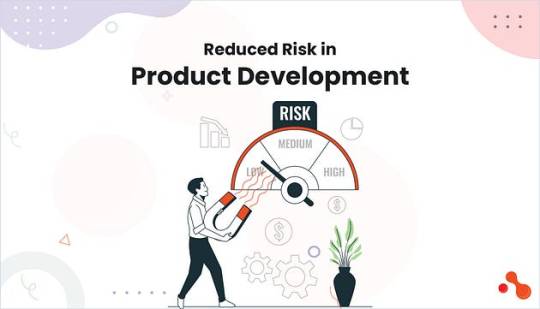
IT staff augmentation reduces that risk dramatically. Top providers offer talent replacements, backup developers, and even code quality audits. This ensures you stay on track even if disruptions occur.
You don’t face legal or HR liability for developers. No contracts, no severance, no employment complexity. With staff augmentation for startups, you also reduce dependency on a single hire or freelancer. If someone drops out, the provider replaces them instantly. This gives your startup more room to focus on growth, not hiring logistics.
A reliable IT staff augmentation company also supports compliance, data protection, and communication standards. This is crucial in fintech, healthcare, or any regulated space. Less admin work means more energy for building your product and business!
Global Mindset, Local Execution
With the follow-the-sun model, your product development continues around the clock. While one team signs off, another team picks up the next sprint cycle. This boosts delivery speed and supports 24/7 progress.
Startups that adopt this model also increase cultural and domain diversity. A fintech product benefits from insights across the US, India, and Europe. A healthcare tool gains more inclusive thinking when built by a globally distributed team. Staff augmentation for startups unlocks these advantages. You build faster, think bigger, and localize smarter.
By hiring global developers through a trusted IT staff augmentation company, you get the best of both worlds. Strategic talent execution happens locally. But product thinking stays global.
Bottomline
In 2025, IT staff augmentation is no longer just a workaround. It’s a proven model built for scale. Startups using this approach gain rapid access to skilled developers, control hiring costs, and accelerate MVP delivery. They reduce risk, maintain code quality, and expand globally without expanding payroll.
The benefits of IT staff augmentation align perfectly with how modern startups grow. It’s how high-performing startups build momentum, meet deadlines, and secure funding. Staff augmentation for startups gives you an edge that traditional hiring can’t. IT staff augmentation company partnerships deliver the talent, flexibility, and speed modern startups demand!
#IT staff augmentation company#hire Laravel developers#what is staff augmentation#benefits of IT staff augmentation
0 notes
Text
Top Cost-Saving Strategies for Startups Hiring Developers in 2025
Introduction
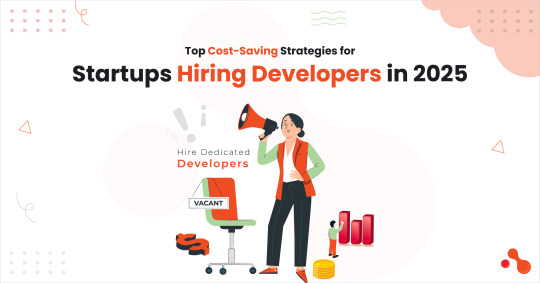
In 2025, startups are under more pressure than ever to innovate rapidly without burning through capital. The traditional model of building large, in-house development teams is increasingly being questioned as startups seek agility, specialized skills, and cost-efficiency.
Hiring developers was once a straightforward decision, but this is no longer the case. It is now a complex balancing act between costs, quality, and scalability leaving businesses asking the question how to hire developers for startup?
With inflationary pressures, rising salaries in tech hubs, and the global competition for skilled talent, founders are facing a new dilemma, hence asking the critical question: How do we build a strong dev team without going broke?
The answer lies in smart hiring—particularly outsourcing and staff augmentation. This article outlines cost-saving strategies for startups when hiring developers in 2025, supported by real-world case studies, statistics, and expert advice.
Early-Stage Startups Struggles
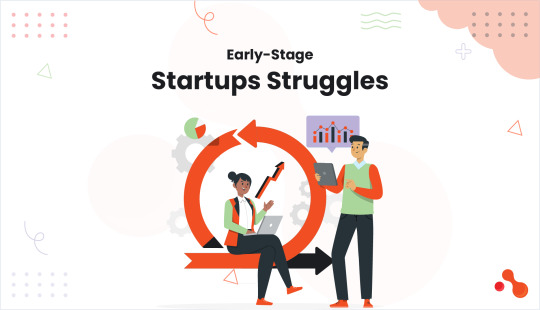
Early-stage startups, by their very nature, operate within tight financial constraints. They face an uphill battle when it comes to attracting and retaining top-tier developer talent with many wondering: How much does it cost to hire a developer?
Here is what their early struggle involves:
With limited budget and compensation constraints they cannot compete with packages offered by tech giants.
Lack the brand recognition that draws in passive candidates.
There is a lot at stake in every minor business decision with a single misstep significantly impacting project timelines.
Hiring in-house developers involves a multitude of hidden costs.
For startups, the most expensive line of code isn't the one written — it's the one paid for but never used. Every unused feature drains the budget without delivering value. This is very true for startups who tend to worry about how to build a tech team on a budget?
The Shifting Sands of Developer Hiring in 2025

The demand for specialized tech skills continues to outpace supply. This scarcity drives up salaries and benefits, making in-house hiring a significant financial burden for nascent companies.
There are several affordable ways to hire developers to ensure it does not burn a hole in your startup’s tight budget. Here are a few interesting statistics:
IT outsourcing revenue is expected to reach a staggering $591.24 billion USD in 2025.
The offshore software development market is expected to rise to $151.9 billion in 2025 and $389.7 billion by 2033.
92% of G2000 companies depend on IT outsourcing.
There are multiple models available to businesses for hiring remote developers for startups as mentioned below, besides which there is also the option to hire in-house developers:
Freelancer developers
Outsourcing
IT staff augmentation
Top Cost-Saving Strategies
Hiring remote developers over in-house ones is highly beneficial when it comes to cost-cutting.
Freelancers tend to be unreliable; however, startups have the option to either outsource or embrace staff augmentation.
Here are a few strategies for businesses wondering how to hire developers for startup
Hire Remote Developers from Cost-Effective Regions:
Hiring remote developers for startups isn’t just about flexibility—it’s about geography.
Hiring from regions like India and Philippines ensures more cost-effective software development.
Rates vary across the globe. Best countries to hire developers 2025:

Use Specialized Agencies Instead of Freelance Platforms:
Agencies that specialize in IT staff augmentation ensure pre-vetted developers, replacement guarantees, ongoing project management support and skillset alignment with your tech stack. This model ensures continuity and minimizes the risk of attrition during critical development phases.
Avoid Over-hiring:
Startup founders often make the mistake of hiring too many specialists too early.
Reduce your dependency on multiple hires and keep your team agile.
Hire a skilled set of developers and avoid over-hiring.
Scale Flexibly with Monthly Contracts, Not Full-Time Salaries:
Hiring full-time employees comes with long-term obligations.
Staff augmentation is more flexible - you can hire monthly, pause, or scale based on project load.
Invest in Code Reusability and DevOps Automation Early:
Save by hiring cheaper and writing smarter code.
Encourage your team to build reusable components, use Laravel packages efficiently, and implement CI/CD pipelines.
Automate testing and deployments.
Implementing these strategies helps reduce development time, minimize bugs, and accelerates your release cycles—saving both time and money.
Choose the Right Engagement Model for Your Project Lifecycle:
Not every startup needs the same engagement model.
Align your project needs with the right model to avoid scope creep and over commitment—common financial pitfalls for early-stage startups.
Start with a Pilot Before Committing Fully:
Whether you’re outsourcing for the first time or switching vendors, always begin with a pilot project.
Test communication workflows, validate code quality, and evaluate cultural and process fit.
Hiring remote developers that offer flexible onboarding and short-term trials without long lock-ins will pay off.
These cost saving strategies offer a vital insight into how to hire developers for startup. The article goes on to provide more details on the benefits of outsourcing and opting for staff augmentation.
The Power of Outsourcing Development Requirements

Outsourcing software development requirements is a smart business decision especially for startups. It is no longer viewed with skepticism, but has matured into a sophisticated and highly effective strategy for startups.
Top cost-saving strategy - Outsourcing
Here is how outsourcing is the most cost-effective solution:
Access to a Global Talent Pool: Outsourcing opens doors to highly skilled talent from all around the globe. It provides the startups access to highly quality solutions at significantly lower rates.
Reduced Overhead and Operational Costs: Outsourcing helps eliminate the overheads associated with recruiting top-notch developers. This includes the recruitment costs, benefits, office space, equipment, utilities, training, as well as administrative overhead.
Faster Time-to-Market and Scalability: When you outsource to a professional software development company there is no delay to start the development process. They implemented proven methods and have access to the latest technology to reduce time-to-market.
Focus on Core Competencies: The startups can focus on more pressing business matters by delegating development tasks to the professionals.
Outsourcing isn’t just a cost-cutting move it’s a strategic solution especially in 2025 when technology is making it easy for businesses to launch their products and services.
IT Staff Augmentation: A Hybrid Approach
When it comes to getting work done, staff augmentation is a pretty neat trick. Instead of just handing off a whole project to an outside company:
Filling in the Blanks: Ever been in a spot where you need a super specific skill for a short burst? Staff augmentation lets you bring in vetted experts without all the usual hiring headaches.
Flexibility is Key: You can scale your workforce up or down in a flash, depending on project demands, busy seasons, or if something unexpected pops up.
Budget-Friendly: While it might not always beat full project outsourcing on price, staff augmentation can still be incredibly cost-effective.
Strategic Implementation for Maximum Savings
Several key elements influence the total cost to hire remote developers. To genuinely reduce expenses while ensuring high-quality outcomes, startups should keep the following best practices in mind:
Define Clear Requirements:
Always define project scope, technical requirements, desired skills, and expected deliverables first. It is best to have a clear picture of the project's scope prior to engaging any external partner. Ambiguity leads to scope creep and increased costs.
Select the Right Engagement Model:
Decide whether a fully outsourced project or a staff augmentation approach fits better with your goals, budget, and how much control you want to retain. Each model has its advantages depending on your stage and needs.
Prioritize Thorough Evaluation:
Vet candidates or agencies rigorously and avoid making decisions exclusively based on the cost of development. Verify their technical expertise, communication skills, past project success, and cultural compatibility and ensure they have a proven track record.
Start Small:
Consider starting small with limited requirements like an MVP. This is a good opportunity to assess compatibility and performance before committing to larger engagements.
Leverage Project Management Tools:
Make the most of the advanced tools to streamline project management and communication. This is vital since it helps improve visibility, coordination and ensures everyone stays aligned on deadlines and responsibilities.
Conclusion
With stiffer competition as building top-notch solutions becomes simpler in 2025, businesses need a good strategy. Hence startups need to build and iterate quickly while maintaining financial prudence.
This article provides details on several startup developer hiring models. It explains how the traditional model of hiring a large, expensive in-house development team is often unsustainable.
Outsource development requirements and reap the benefits, it is the ideal cost-saving strategy.
FAQ
What’s the most cost-effective way for startups to hire developers in 2025?
Hiring remote developers or outsourcing to trusted development agencies often proves the most budget-friendly while maintaining quality.
Is outsourcing still viable for startups in 2025?
Yes. Strategic outsourcing helps reduce infrastructure and hiring costs while accessing global talent pools.
How can startups ensure quality while saving costs on development?
Prioritize MVP development, choose skilled yet affordable developers, and use hybrid hiring models combining in-house and outsourced talent.
What are some common hiring mistakes startups make in 2025?
Over hiring early, ignoring remote options, and choosing price over proven expertise are common mistakes.
Original Source: https://medium.com/@mukesh.ram/top-cost-saving-strategies-for-startups-hiring-developers-in-2025-1debaf532156
#Hire Remote Developers#Cost-effective software development#how to hire developers for startup#remote developers for startups#Hiring Cost
0 notes
Text
WordPress Accessibility Guide 2025: Practical Tools and Compliance Essentials

Let’s face it, WordPress accessibility guide 2025 isn’t just a checklist for developers anymore. It’s about real users having real trouble using your website if it’s not inclusive. You must plan to hire a remote WordPress developer to make sure your project defines all the benchmarks of today’s digital trends!
Millions of people browse the web with screen readers, keyboard navigation, or color-adjusted screens. If your WordPress site doesn’t support them, you’re losing traffic and trust, maybe even risking legal action.
This guide will walk you through the basics of making your WordPress site more accessible. From smart plugin picks to WordPress ADA compliance solutions, and tips on testing, we’ve packed it all in!
Starting First! Understanding WordPress Accessibility
What Is Website Accessibility?
For instance, a user relying on a screen reader must be able to navigate your blog post just as easily as someone scrolling with a mouse. In WordPress, it covers alt text for images, keyboard-friendly navigation, color contrast, readable fonts, form labels, and ARIA roles.
With over 1.3 billion people worldwide living with some form of disability (WHO), ensuring your site is inclusive is a strategic move. For e-commerce sites, blogs, or SaaS platforms built on WordPress, ignoring accessibility means excluding millions of potential users. A worthy WordPress website development company can help you achieve the mark of being highly accessible!
Key Accessibility Principles: The POUR Model
To make WordPress accessibility practical, the POUR framework serves as your foundation:
1. Perceivable
Users must be able to detect all UI elements, text, images, audio, and video. That means:
Use alt tags for every image.
Offer transcripts or captions for multimedia.
Avoid color-only indicators (e.g., don’t use red text to show errors alone).
2. Operable
Your site must work for users who:
Navigate via keyboard (tab, shift-tab, enter).
Use adaptive tools like screen readers or eye-tracking software.
Need sufficient time to complete actions like filling out forms.
3. Understandable
Structure your site with clear navigation and stick to common design conventions. Ensure error messages are easy to spot and correct. For example:
Use consistent layouts across all pages.
Label buttons with clear actions (“Submit,” not “Go”).
Avoid technical jargon or complex phrases.
4. Robust
Accessible content must remain valid as browsers and assistive technologies evolve. That means:
Valid HTML5 structure.
ARIA roles were necessary.
Regular plugin/theme updates to prevent breakages.
The Impact of Accessibility on UX, SEO, and Trust
User Experience
From font scaling to contrast adjustments, inclusive design equals a better experience for everyone. On mobile devices, these principles are even more vital.
SEO Rankings
Google’s Core Web Vitals intersect with many accessibility standards. Optimizing for accessibility often boosts SEO naturally.
Alt text = better image SEO.
Clean markup = faster indexing.
Descriptive links and headers = clearer site structure.
Brand Trust and Legal Safety
In the US alone, ADA lawsuits for inaccessible websites rose 12% in 2024. If your WordPress site isn’t accessible, you risk both revenue and legal penalties. If you’re offering WordPress development services, accessibility should be part of your pitch.
Important Accessibility Standards You Must Know (2025 Update)

Whether you’re a developer, agency, or business owner, staying compliant with recognized accessibility standards is critical for any WordPress website. Let’s walk through the three major standards that directly impact your WordPress ADA compliance solutions and clear up the most common legal myths around them.
WCAG 2.2 Guidelines
The Web Content Accessibility Guidelines (WCAG) form the backbone of global web accessibility. The latest version, WCAG 2.2, builds on earlier guidelines and introduces refinements focused on mobile usability and cognitive impairments.
Key criteria in WCAG 2.2:
Focus appearance: Ensures users can see where they are navigating via keyboard.
Dragging movements: Replaces drag-and-drop with tap alternatives.
Consistent help: Guarantees help content is persistent on every page.
These standards categorize compliance into three levels:
A: Basic accessibility.
AA: Recommended for public-facing websites.
AAA: Advanced and often not fully achievable.
For anyone offering WordPress development services, achieving at least Level AA compliance should be non-negotiable. Most of the best WordPress accessibility plugins 2025 are designed specifically to meet these WCAG criteria.
ADA Compliance (Americans with Disabilities Act)
The ADA Title III requires that digital platforms be accessible to users with disabilities. Although the law does not explicitly name WCAG, most legal experts and courts reference WCAG 2.1 AA or 2.2 AA as the standard benchmark in litigation.
Lawsuits have surged over the last few years. Over 4,500 ADA lawsuits were filed in the U.S. in 2024 for digital inaccessibility. If you run a business website and serve U.S. customers, your site needs to meet ADA standards, especially if you offer services or sell products online.
EN 301 549 (EU Standards)
For European businesses or any site serving EU users, EN 301 549 is the standard enforced under the European Accessibility Act. It mandates accessibility for public sector websites, mobile applications, and increasingly for private entities in 2025. If you rely on WordPress ADA compliance solutions, make sure you understand the legal scope these tools claim to cover!
EN 301 549 directly references WCAG guidelines, but also includes:
Hardware and software interoperability
Assistive technology integration
Real-time text communication standards
Whether you choose to hire a WordPress plugin developer or agency, ensure they consider these regional requirements when customizing functionality:
Common Misconceptions About Legal Requirements
Many site owners and developers fall into traps due to misinformation. Let’s clear a few things up:
My site isn’t for government or healthcare, so I’m exempt.
Wrong. ADA applies to all public-facing websites in the U.S. with commercial offerings.
I installed a plugin, so I’m compliant.
Plugins help, but they don’t guarantee full compliance. Manual audits and developer input are essential.
No one will sue a small business.
Wrong again. Most lawsuits target small to mid-sized businesses because they often lack compliance knowledge or legal defense.
Accessibility is a one-time fix.
Accessibility is an ongoing process. Every theme update, plugin installation, or content change can affect it.
Top WordPress Accessibility Plugins to Use in 2025

While plugins can’t do everything, they serve as an essential layer in your WordPress ADA compliance solutions. Combining them with help from a WordPress website development company or hiring a WordPress plugin developer can help you build and maintain accessibility the right way!
Below is a curated list of the best WordPress accessibility plugins for 2025:
One Click Accessibility
Perfect for beginners, this plugin adds accessibility features like skip links, font resizing, and contrast toggles with a single install. Lightweight and fast.
Best for: Small business sites and blogs looking for quick WCAG wins.
WP Accessibility Helper (WAH)
A more advanced plugin that offers contrast adjustment, font controls, and ARIA landmarks. It includes WCAG checklists and paid options for detailed audits.
Best for: Developers and agencies managing multiple accessibility points.
UserWay Accessibility Widget
This cloud-based tool adds an accessibility widget that users can toggle. It covers contrast, font size, and screen reader adjustments.
Best for: Public-facing websites needing on-screen control options.
AccessiBe
One of the most widely used WordPress ADA compliance solutions, AccessiBe, uses AI to scan and apply accessibility fixes dynamically. It’s fully managed, but premium-only.
Best for: Businesses facing legal risk or needing full automation and audits.
WP ADA Compliance Check Basic
Audits your site and flags compliance issues. Ideal for spotting image alt text issues, missing labels, and structural HTML problems.
Best for: Developers needing fast compliance diagnostics.
Accessibility by UserWay
Similar to the UserWay Widget but with more configuration and branding controls. Integrates with screen readers and is WCAG 2.1-compliant.
Best for: Agencies and developers looking to white-label their accessibility efforts.
Let’s understand this more with this quick comparison table:
Plugin Comparison Table: Free vs Paid Features (2025)
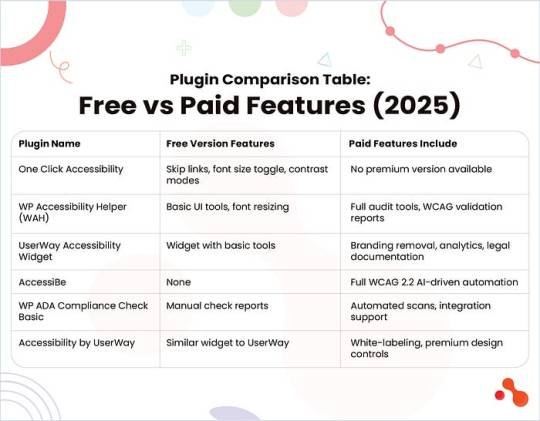
Best Practices to Build an Accessible WordPress Site

These tips align with the latest guidelines from the WordPress accessibility guide 2025 and help you deliver real accessibility value to all users.
Use Correct HTML Semantic Markup
Always structure your site using <header>, <nav>, <main>, <section>, and <footer> tags properly. Use heading levels (<h1> to <h6>) in a logical order. Screen readers rely on this hierarchy to make sense of the page.
Ensure Color Contrast Ratios
Poor contrast affects readability for users with low vision. Follow WCAG 2.2 recommendations: 4.5:1 contrast ratio for normal text and 3:1 for large text. Use tools like WebAIM Contrast Checker to evaluate your color palette.
Add Alt Text to All Images
Descriptive alt text helps screen readers convey image context. Avoid using vague descriptions like “image” or “picture.” When using decorative images, add an empty alt=”” tag to skip unnecessary narration.
Enable Keyboard Navigation
Users with mobility impairments often rely on keyboards. Make sure all elements, menus, buttons, and forms are focusable using the Tab and Enter keys. Avoid JavaScript-only interactions that block keyboard access.
Support Screen Readers
Use ARIA roles and landmarks thoughtfully. Ensure live regions, modals, and dynamic content updates are properly announced. Test using tools like NVDA or VoiceOver to confirm your site works with real screen readers.
Avoid Auto-Playing Media
Videos or audio that play automatically can disorient users. If you must include auto-play content, provide clear pause and volume controls. This is critical for compliance under WordPress ADA compliance solutions.
Create Accessible Forms
Label every input clearly and consistently. Use <label> tags tied to their corresponding fields using the for attribute. Include helpful error messages and confirm button states that are easy to understand for users with screen readers or visual challenges.
How to Test Your WordPress Site for Accessibility?
Building an accessible site is just the beginning. You must test and audit it regularly to make sure it’s truly usable for everyone.
Here’s how you can test your WordPress site the right way!
Manual Testing Tips
Manual testing reveals issues that tools often miss. Try these steps:
Keyboard-Only Navigation: Can you navigate through all menus, forms, and links using only the Tab, Shift+Tab, and Enter keys? If not, users with mobility challenges may face barriers.
Screen Reader Simulation: Use screen readers like NVDA (Windows) or VoiceOver (macOS) to simulate how visually impaired users interact with your site. Listen for proper heading flow, button labeling, and announcements for dynamic content.
Form Accessibility Check: Test all form fields and validation states. Confirm if users receive clear error messages and can complete forms using assistive tech.
Automated Tools

Regular Audits and User Testing
Schedule monthly or quarterly audits using both tools and human testers, especially if your site updates frequently. You can involve users with disabilities in your testing cycle. Their feedback will help uncover edge cases and improve real-world usability beyond plugin coverage.
Common Accessibility Mistakes to Avoid
Even with the best plugins and tools, small mistakes can ruin the user experience. The WordPress accessibility guide 2025 points out that many site owners rely too heavily on automation or overlook mobile usability, two things that can break compliance.
Here’s what to avoid:
Relying Only on Plugins Without Manual Review
Plugins are helpful, but they aren’t perfect. They won’t catch incorrect heading structures, misleading link text, or poorly labeled form fields. For example, a plugin might not flag a CTA that says “Click Here” with no context. Always pair plugins with manual reviews and expert insight.
Ignoring Mobile Accessibility
Accessibility must extend beyond desktops. On mobile, buttons that are too small or layouts that shift can make navigation frustrating. Users who rely on screen magnifiers or touch navigation need a layout that adjusts with clarity and predictability.
Overusing Popups and Animations
Auto-triggered popups or moving elements can disorient users with cognitive disabilities. Flashing banners or background animations may also trigger seizures in sensitive users. Always offer ways to pause or disable motion.
Assuming Accessibility is a “One-Time” Project
Accessibility is a continuous process. New content, plugins, or theme updates can break previously compliant elements. Just because your site passed a test last year doesn’t mean it’s still accessible today.
Tip: Hire a WordPress plugin developer who ensures long-term compliance with each change or feature rollout!
Benefits of an Accessible WordPress Site
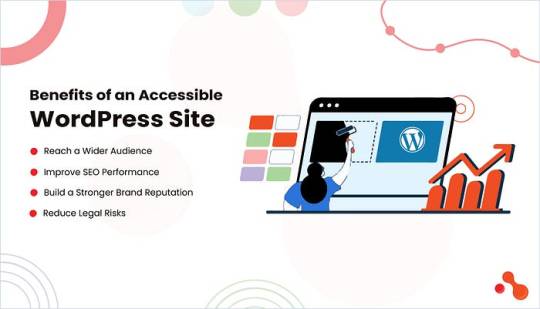
Following the WordPress accessibility guide, 2025 is a growth opportunity. An inclusive website doesn’t just help people with disabilities. It helps your brand grow faster, rank higher, and stay safer from legal trouble.
Reach a Wider Audience
More than 1.3 billion people globally live with some form of disability, which is over 15% of the population. By making your site accessible, you unlock a huge segment of users who are often excluded from digital experiences. Whether it’s visual impairments, motor limitations, or cognitive challenges, accessibility ensures every visitor can use your site.
Improve SEO Performance
Google’s algorithm rewards accessibility. Features like proper HTML structure, alt tags, ARIA roles, and keyboard navigation all improve crawlability and user experience, core factors in ranking. Many WordPress ADA compliance solutions align closely with technical SEO best practices, so improving one boosts the other naturally.
Build a Stronger Brand Reputation
In 2025, consumers value inclusivity. Accessibility sends a clear message: your brand cares about all users. It improves customer loyalty and adds weight to your ESG and DEI positioning. Startups and enterprises alike are now embedding accessibility into their development roadmap.
Reduce Legal Risks
In the U.S., the number of ADA lawsuits related to inaccessible websites has grown steadily. Internationally, laws like the European Accessibility Act are enforcing stricter standards. A non-compliant website can lead to fines, lawsuits, or even takedown orders. Staying compliant with the latest WordPress ADA compliance solutions reduces this risk and keeps your business legally safe.
Bottomline
As the WordPress accessibility guide 2025 has shown, relying solely on plugins won’t guarantee a fully accessible or legally compliant experience. Tools like WP ADA Compliance Check Basic or One Click Accessibility speed up your workflow, but the real value lies in aligning your site with WCAG 2.2, ADA guidelines, and global standards like EN 301 549.
0 notes
Text
Top 7 Mistakes to Avoid When Hiring an IT Staff Augmentation Partner
Introduction

In 2025, choosing the right IT staff augmentation partner defines whether your startup grows or stalls. More founders now adopt this model to access global developers, launch faster, and scale smartly.
The model works well, but the wrong partner leads to disaster. You risk delays, bloated costs, and code that fails under load. One bad engagement can stall your roadmap, ruin deadlines, or force a rewrite.
A recent study indicates that 74% of employers struggle to find the skilled talent they need, underscoring the importance of choosing a reliable augmentation partner. Startups rush into agreements without understanding the benefits of IT staff augmentation, or they fail to compare options.
In this guide, you’ll learn:
Why do IT staff augmentation services work best when aligned with your business goals?
The 7 costly mistakes founders and CTOs make while choosing an augmentation partner
What to look for in an ideal staff augmentation model for startups in 2025?
How to avoid risk, delays, and poor ROI with smarter vendor evaluation?
Mistake #1: Ignoring Technical Vetting Standards
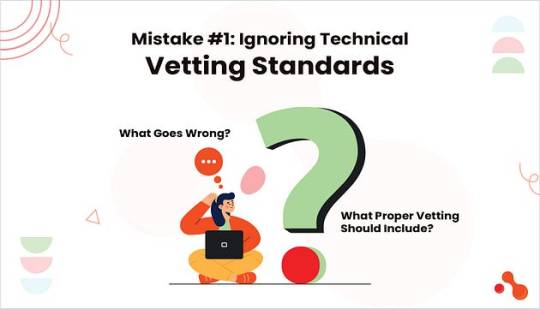
One of the biggest mistakes when choosing an IT staff augmentation partner is skipping the vetting process. Many providers promise “vetted talent,” but fail to evaluate real-world coding skills, system architecture thinking, or experience with modern frameworks.
❌ What Goes Wrong?
Developers ace theoretical interviews but fail during hands-on implementation. Reasons are -
Teams lack experience in tools you depend on, like Laravel, Kubernetes, or GitHub Actions.
Poor performance in sprint delivery, unit testing, or code review processes.
Lack of familiarity with product lifecycle, CI/CD pipelines, or post-deployment maintenance.
When technical vetting is missing or shallow, the result is broken sprints, missed deadlines, and unstable product builds.
✅ What Proper Vetting Should Include?
A reliable IT staff augmentation company conducts multiple layers of evaluation:
Live coding assessments that test for problem-solving and logic under pressure
Architecture review tasks that simulate backend planning, scalability, and service orchestration
Laravel-specific challenges for MVC structure, queue jobs, API design, and database logic
DevOps case studies that check knowledge of CI/CD, containerization, monitoring, and rollback handling
Soft skills and communication checks to ensure smooth integration with your product team
This level of depth separates mediocre outsourcing from trusted IT staff augmentation services that deliver.
Mistake #2: Overlooking Communication & Timezone Alignment

Startups often assume that hiring skilled developers guarantees smooth collaboration. That’s a major mistake. Even the best talent will fail your product if communication breaks down.
Choosing an IT staff augmentation partner without considering timezone and communication alignment results in missed updates, poor coordination, and frustration for internal teams.
❌ Why This Mistake Happens?
Founders focus only on technical skills, ignoring soft skills and cultural fit.
Developers respond to messages late or miss key meetings due to timezone gaps.
Language barriers slow down feedback cycles, sprint reviews, or dev handoffs.
Product managers waste hours trying to explain stories or resolve simple blockers.
This leads to slow product cycles, failed QA loops, and delayed launches.
✅ What to Look For Instead?
A reliable IT staff augmentation company ensures smooth communication and timezone compatibility with:
Daily or alternate-day syncs that keep progress transparent and blockers visible
English fluency assessments during vetting to ensure seamless collaboration
4+ hours of timezone overlap with your product or engineering team
Agile reporting via tools like Slack, Jira, Notion, or Trello
Clear escalation paths for blockers or scope shifts
For staff augmentation for startups, communication speed is just as important as coding speed.
If you plan to hire remote developers for startups in the US or UK, timezone matching becomes a strategic decision, not just a convenience.
Mistake #3: No Focus on Security or IP Protection

Startups often prioritize speed and talent, but forget a critical layer security and intellectual property protection. Choosing an IT staff augmentation partner that lacks security standards can put your codebase, customer data, and product IP at serious risk.
❌ What Can Go Wrong?
Developers work in unsecured environments with no VPN or endpoint protection
No signed Non-Disclosure Agreements (NDAs) to protect product concepts or data
Git access was shared without proper permission levels
No clear boundaries around third-party code usage or version history logging
Customer data left exposed in staging or QA environments
A report by IBM found that the average cost of a data breach in 2024 was $4.45 million, the highest ever recorded. This proves that startups must go beyond code quality and prioritize IP control from day one!
✅ What to Ensure Before Signing?
A trustworthy IT staff augmentation company will:
Sign NDAs and IP assignment clauses before project kickoff
Provide secure remote development infrastructure
Use Git with access control, audit logs, and branch permissions
Train developers on data privacy laws like GDPR and HIPAA
Provide documentation on internal security practices
This level of compliance is essential for staff augmentation for startups, especially in fintech, healthtech, and SaaS sectors. If you plan to augment your software development team, make IP protection a non-negotiable.
Mistake #4: Picking Based on Lowest Price Alone

Every startup watches its budget, but choosing an IT staff augmentation partner based only on price leads to failure. Startups that chase cost over quality end up with missed deadlines, buggy code, and zero accountability.
❌ Real-World Example: When Cheap Fails
A B2B SaaS startup hired a $12/hour developer to build a Laravel admin dashboard.
Within four weeks:
APIs failed under test loads
Data wasn’t sanitized, exposing user records
Dev didn’t follow MVC conventions
No Git usage, no CI/CD, no documentation
The founder had to scrap the entire codebase and rehire a vetted Laravel developer. The “cheap hire” ended up costing 3x more and delaying investor demo day by a month.
✅ What You Should Evaluate Instead?
A smart IT staff augmentation company adds value beyond just writing code. Here’s what to look for:
Relevant experience in your industry or product stage
Turnaround time from onboarding to first commit
DevOps support for scalable infrastructure, CI/CD, and deployment
Tech match for your stack: Laravel, React, Node, etc.
Quality assurance and support coverage
If you’re using staff augmentation for startups, remember that you’re not just paying for hours; you’re paying for delivery, velocity, and risk reduction. Founders who hire remote developers for startups should weigh total ROI.
Mistake #5: Lack of Industry or Tech-Specific Experience

Hiring an IT staff augmentation partner without relevant tech or industry experience slows down your build and risks product failure.
A Laravel SaaS platform needs different skills than a React MVP or a Python-based AI tool. Yet many founders skip this evaluation and choose based on availability alone. This mismatch affects planning, speed, and even how scalable the foundation becomes.
❌ Why This Fails?
A Laravel developer unfamiliar with SaaS patterns may skip multi-tenant architecture or queue handling
A React developer without MVP experience may overengineer a simple prototype
AI-focused projects fail when engineers lack domain knowledge in ML frameworks or data ops
✅ What to Check Before Onboarding?
A strong IT staff augmentation company will match developers by:
Framework expertise: Laravel, React, Node, Python, etc.
Use case familiarity: SaaS apps, eLearning platforms, fintech tools, etc.
Deployment patterns: Single-tenant vs multi-tenant, API-first, headless CMS, and microservices
Previous portfolio: Look for examples in your product domain
For staff augmentation for startups, the match must go deeper than tech skills. It must align with product vision, tech stack, and industry compliance if applicable.
Founders should always ask:
“Have you worked on a project similar to mine before?”
Choosing to augment your software development team with the wrong expertise risks time, trust, and technical debt.
Mistake #6: No Trial Period or Developer Replacement Policy

Even top developers sometimes fail to deliver. But if your IT staff augmentation partner doesn’t offer a replacement policy, you’re stuck with poor performance or forced to start over. This delay hurts momentum, especially for MVP-stage startups or teams pushing product demos to investors.
❌ What Happens Without a Trial or Exit Policy?
The developer underdelivers, but you’ve already paid for 4+ weeks
Lack of a process to escalate performance issues
No way to rotate developers without renegotiating the agreement
You waste sprint cycles while waiting for a fix
✅ What a Good Augmentation Partner Offers?
A quality IT staff augmentation company includes:
Free replacement guarantees during the first 2–4 weeks
Trial periods to test communication, delivery, and velocity
No-penalty exit terms if performance doesn’t match the promise
Proactive replacements if developer feedback turns negative
Mid-project flexibility to scale up or rotate skill sets
For staff augmentation for startups, this flexibility keeps projects stable, even when something goes wrong. If you plan to hire remote developers for startups, make the trial clause your first question.
Mistake #7: Ignoring Delivery Process and Project Management Tools

Hiring an IT staff augmentation partner without understanding how they manage delivery leads to miscommunication, delays, and lack of control. Transparency equals trust. And for startups, visibility into daily progress is critical, it’s not enough for developers to write code. You need clear project flow, sprint alignment, and real-time collaboration.
❌ What Goes Wrong Without Process Visibility?
You don’t know what’s being worked on, when it’ll be ready, or who’s blocked
Features get delivered late or out of scope
Git commits lack comments, issues go untracked, and documentation is missing
You aren’t looped into retrospectives or sprint demos
The result? You burn time chasing updates instead of leading product strategy.
✅ Tools and Habits to Expect from a Real Augmentation Partner
A modern IT staff augmentation company will use tools that bring you inside the build process:
Jira or Trello for task tracking and sprint planning
Slack or Teams for async updates and daily standups
Git with branch control and pull request reviews
Notion or Confluence for documentation and SOPs
Weekly sprint reviews and retrospectives to evaluate velocity and adjust plans
For staff augmentation for startups, these systems mean faster issue resolution, better product quality, and complete delivery control. If you plan to augment your software development team, ask about tool stack, sprint cadence, and reporting habits!
How to Choose the Right Partner?
Selecting the right IT staff augmentation partner means going beyond availability. It requires a system to vet capabilities, processes, and reliability.
Here’s a proven checklist to help you:
✅ What to Ask Before You Sign?
#1 Do you have case studies in my domain?
Ask for real examples: Laravel SaaS, React MVPs, or Bagisto-based eCommerce.
#2 Are your developers certified in key stacks?
Look for Laravel, Statamic, or Bagisto credentials to validate skill alignment.
#3 What’s your onboarding process?
Ask how long it takes to get project-ready. Time-to-first-commit matters.
#4 How do you ensure developers are project-ready?
Evaluate screening, shadow sprints, and onboarding documentation.
#5 Do you support code reviews and retrospectives?
Process matters more than promises. Look at their workflow before trusting delivery timelines.
🔍 Why Acquaint Softtech Sets the Standard?
As a vetted IT staff augmentation company, Acquaint offers:
Laravel-certified developers with project-ready experience
Real case studies in SaaS, fintech, and marketplace apps
48-hour onboarding with milestone-based reporting
Slack, Git, Notion, and Jira integration from day one
Optional 1-week trial with zero lock-in
This is what strategic staff augmentation for startups looks like.
Bottomline
Hiring fast helps you launch, but hiring right helps you scale without setbacks. Choosing the right IT staff augmentation partner ensures fewer delays, cleaner code, secure IP, and developers who understand your tech stack and vision. In 2025, strategy wins over speed.
When you augment your software development team with a vetted partner like Acquaint Softtech, you get scalable systems, sprint-ready developers, and delivery that matches ambition
#what is staff augmentation#benefits of IT staff augmentation#staff augmentation vs outsourcing#IT staff augmentation services
0 notes
Text
Maximize Remote Developer ROI in 2025: A Tactical Guide for Startup Success
Introduction
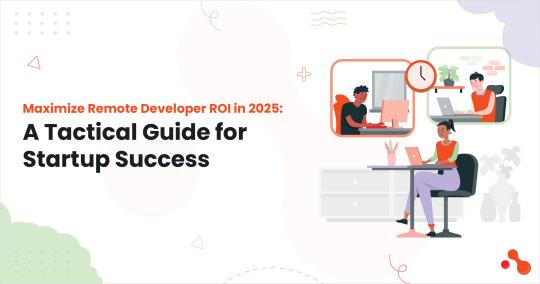
In 2025, startup founders face constant pressure to deliver faster, build leaner, and stay scalable without compromising quality. Hiring mistakes can derail entire funding rounds of your business. That’s why understanding Remote Developer ROI is essential!
Founders looking to hire remote developers aren’t just trying to save money. They want stronger delivery velocity, better code quality, and faster time to market. With access to global talent and flexible engagement models, remote hiring has become a strategic advantage.
According to remote developer hiring trends 2025, startups with distributed teams outperform their peers in cost efficiency and sprint throughput. However, achieving high ROI isn’t automatic. It requires careful selection, onboarding, and delivery tracking.
What Does ROI Mean in Remote Developer Hiring?

Most founders think ROI in hiring is all about saving money. But true Remote Developer ROI blends speed, flexibility, code quality, and delivery consistency. All these are measured against the cost of acquiring and managing talent.
Formula for calculating ROI:
ROI = (Speed to Market + Code Quality + Productivity + Flexibility) ÷ Developer Hiring Cost
For modern startup product development models, even one delayed sprint can affect investor confidence or push GTM timelines. When bugs pile up or developers can’t match your pace, the cost is not hourly, it’s strategic. That's why evaluating ROI means tracking more than just rate cards!
A well-aligned developer may cost less on paper but generate far greater value by shipping faster, communicating better, and writing maintainable code.
Note: “Hiring a $15/hr developer who delivers 3x faster is better than a $50/hr dev who burns sprints.”
Why Remote Developers Offer Better ROI in 2025?
Remote developers offer speed, flexibility, and access to global talent, all of which add up to better returns across the product lifecycle.
Here’s how remote teams outperform traditional in-house hiring:
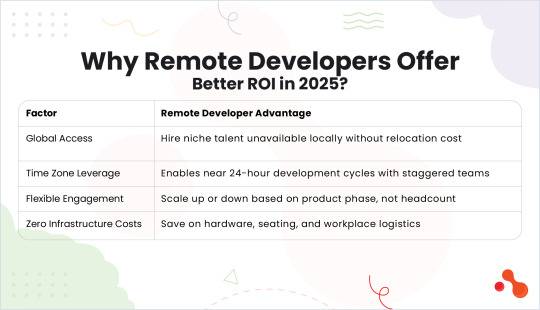
For startups prioritizing lean and fast delivery, the offshore developer ROI is significantly higher when teams are integrated properly. With async tools like Notion, GitLab, and Loom, remote setups no longer mean fragmented workflows.
According to remote developer hiring trends 2025, the top-performing startups are remote-first by default. 85% of managers believe remote work improves productivity and reduces unnecessary expenses. This increased efficiency directly improves the offshore developer ROI for startups looking to build lean without compromising velocity.
ROI Breakdown: Cost, Speed, Quality, and Output
Startups in 2025 can no longer afford to look at hiring costs in isolation. The real measure of value lies in the delivery of output per dollar spent. That’s where Remote Developer ROI outpaces traditional in-house hiring, especially for MVPs and fast-moving product teams.
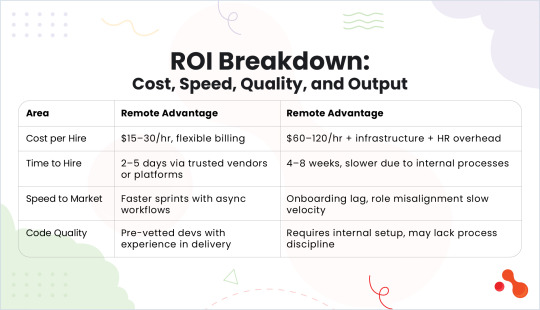
If you are trying to find out how to hire remote developers for your tech startup, these gaps are more than just operational. A delayed release can impact funding, traction, and market trust. When evaluating the cost to hire remote developers, remember you’re not just paying for code. You’re investing in time saved, iterations avoided, and product quality protected.
Hidden Costs of In-House Hiring You Can Avoid
On the surface, in-house hiring may seem like the safer route. But for startups operating under runway pressure, the unseen costs can quickly drain capital and delay momentum.
When you compare Remote Developer ROI with in-house staffing, these hidden expenses become too costly to ignore.
Here are the most common cost traps:
Recruitment Agency Fees: 15–25% of annual salary for each hire
Training & Onboarding Time: Weeks spent before actual delivery begins
Hardware & Workspace: Laptop, desk, tools, and maintenance overhead
Employee Churn Risk: Two-month notice periods, rehiring delays
Underutilized Bench Time: Idle devs still on payroll when workload dips
Founders aiming to hire remote developers avoid most of these costs by using flexible models and outcome-based billing.
Real-world Case Study: Acquaint Softtech
A fintech client cut over $120K annually by switching from internal engineers to affordable Laravel developers in India through our remote team model. With faster onboarding, leaner infrastructure, and on-demand scaling, their delivery speed improved without increasing budget.
In-house hires work best when you have long-term predictability. But in 2025’s startup reality, flexibility wins every time.
How to Maximize ROI When Hiring Remotely?

Hiring remote talent can boost velocity and reduce costs, but only if you do it right!
Maximizing your Remote Developer ROI requires structure, accountability, and the right tech + process alignment.
Here’s how founders can optimize ROI when they hire remote developers in 2025:
Choose the right engagement model
Dedicated remote developers outperform freelancers for most startup product development models. They offer better alignment, long-term accountability, and consistent velocity.
Work with vetted vendors
Partner with platforms or agencies that pre-screen for code quality, communication, and process compliance. Laravel Partners and specialized developer networks offer domain-ready engineers.
Start with a trial sprint
Use a 1–2 week trial sprint to validate code quality, responsiveness, and delivery accuracy before committing longer-term.
Define sprint KPIs
Track productivity through measurable KPIs, delivery speed, PR review turnaround, bug count per sprint.
Leverage async-first tools
Remote developers perform best when plugged into your system: Slack, GitLab, Notion, Jira, and Loom should be defaults, not optional.
Bottomline
For startups in 2025, development is no longer just about writing code; it’s about speed, precision, and return on every dollar spent. When you evaluate the Remote Developer ROI correctly, you realize that smart hiring isn’t a cost-saving tactic. It’s a competitive advantage.
The benefits of hiring remote developers go far beyond affordability. Startups that integrate remote talent with async tools and performance metrics see stronger output, faster delivery, and reduced operational drag. Whether you're launching an MVP or scaling a SaaS platform, the impact is measurable.
Those who focus only on the cost to hire remote developers often overlook how much value is lost through delays, rewrites, and misaligned expectations. But when you hire remote developers who are pre-vetted, process-driven, and product-focused, the returns show up in every sprint.
In global startup ecosystems, the offshore developer ROI is rising because access to niche talent, flexible engagement models, and zero infrastructure costs allow founders to stay lean while shipping faster.
In the end, the decision is not about cheap vs expensive. It’s about who helps you build better, launch faster, and grow smarter without wasting a single resource!
FAQs
What is Remote Developer ROI, and why does it matter for startups?
Remote Developer ROI refers to the return you get from hiring remote developers compared to the total cost invested. For startups, it’s important because the right remote hire can help reduce burn, accelerate product delivery, and maintain code quality!
How do remote developers offer better ROI than in-house teams?
Remote developers eliminate overhead costs like infrastructure, office space, and long onboarding.
When you hire remote developers, you also gain access to
niche skills,
global time zone advantages, and
flexible engagement,
These collectively increase delivery speed and reduce long-term expenses, resulting in stronger offshore developer ROI.
What are the biggest factors that influence the cost to hire remote developers?
The cost to hire remote developers varies by region, tech stack, and experience. However, major cost drivers include sourcing method (freelancer vs agency), engagement type (part-time or dedicated), and project complexity. The real value lies in output quality per dollar, not just hourly rates.
How can I maximize ROI when hiring remote developers for my MVP?
To maximize your Remote Developer ROI for MVPs, choose dedicated developers over freelancers, start with a trial sprint, and define KPIs like sprint velocity and bug resolution time. Platforms offering affordable Laravel developers in India are popular among startups due to their high performance-to-cost ratio.
Original Source: https://medium.com/@mukesh.ram/roi-breakdown-cost-speed-quality-and-output-841bb4c624e2
#benefits of hiring remote developers#cost to hire remote developers#hiring cost#remote developers for startup#hire remote developer
0 notes
Text
10 Key Advantages of Hiring Dedicated Laravel Developers in 2025
Introduction
Hiring dedicated Laravel developers is now a top priority for startups and enterprises building fast, scalable, and secure digital products. Laravel’s modern syntax, built-in tools, and community support make it one of the most efficient PHP frameworks available in 2025.

Laravel is trusted by thousands of SaaS platforms, marketplaces, CRMs, and enterprise applications for its speed and maintainability. But choosing the right technology stack is only one part of the equation. You also need the right people behind the code.
Many teams start by asking why hire laravel developers instead of generalist PHP developers. The answer lies in Laravel’s structure. Without a full-time focus, you risk poor architecture, slow APIs, and inefficient deployments.
That’s where dedicated models prove effective. When you know when to hire full-time Laravel programmers, you avoid fragmented delivery. Dedicated developers work exclusively on your project, delivering faster results with greater accountability!
Let’s uncover 10 real Laravel dedicated developer benefits—
Advantage #1: In-Depth Laravel Expertise at Your Fingertips
Hiring dedicated Laravel developers gives you instant access to deep Laravel framework expertise that general PHP developers can’t match. They stay current with Laravel 10/11 updates, including improved task scheduling, built-in validation, and real-time broadcasting.
Their focused knowledge of Laravel developer skills allows them to make faster architectural decisions, integrate built-in tools efficiently, and reduce future refactoring. It also reduces Laravel development costs for your business.
Startups that hire Laravel experts avoid code duplication, unnecessary plugins, and wasted hours debugging issues already solved within the core framework.
Advantage #2: Faster Project Delivery with Focused Attention
A dedicated Laravel developer brings focused execution. No distractions, no juggling projects — just consistent development output aligned with your roadmap.
This model improves dedicated Laravel developer productivity and supports faster iteration, cleaner sprint delivery, and shorter QA cycles. You gain clear advantages in Laravel speed to market by reducing backlogs and handoff delays.
If you want to launch a Laravel project faster, a dedicated setup provides the clarity and control in execution that part-time models cannot offer.
Advantage #3: Cost-Efficiency Compared to In-House Teams
Laravel developers significantly reduce your development overhead. You save on infrastructure, local employee benefits, payroll taxes, and hardware provisioning.
Instead of fixed monthly salaries and office maintenance, you pay for productive output. This makes the model more efficient than traditional hiring.
The cost of Laravel developer outsourcing destinations is lower without affecting code quality. When you evaluate Laravel outsourcing vs in-house, the savings in HR, onboarding, and workspace become clear.
With dedicated resources, there are no long notice periods or internal hiring delays. You control the budget and scale up or down based on your workload. For startups looking for affordable Laravel development, this approach delivers financial flexibility and stronger cost control throughout the product lifecycle.
Advantage #4: Flexibility in Engagement and Scaling
This level of Laravel project team scalability is not possible with fixed in-house teams or locked retainer contracts. Dedicated models support hourly, monthly, or project-based billing.
Different Laravel developer hiring models let you adapt quickly to product pivots, market changes, or investor-driven milestones. You avoid long-term liabilities and only pay for the resources you need.
Startups benefit from flexible Laravel hiring plans that align with their sprint cycles and budget constraints. You can start with one developer and scale to a full squad when needed.
Advantage #5: Seamless Integration with Your In-House Team
One advantage of Laravel developers is that they adopt your style without disrupting your workflow. These developers integrate smoothly into your internal process and operate like virtual in-house engineers.
From daily standups to sprint reviews, communication remains structured through tools like Slack, Jira, GitHub, or Zoom. This enables consistent Laravel developer collaboration without timezone or access issues.
With the right partner, remote Laravel developer hiring becomes effortless. You maintain control while adding capacity instantly. Developers follow your code standards, version control, and deployment process from day one. If you want to augment your Laravel team without hiring locally, dedicated developers are the fastest and cleanest way to do it.
Advantage #6: Better Quality Control and Accountability
Hiring dedicated Laravel developers ensures consistent delivery with higher accountability. Dedicated resources take full ownership of assigned tasks, timelines, and code integrity.
They follow your sprint structure, commit regularly, and maintain clarity in merge requests and documentation. This directly improves Laravel project quality from planning to deployment.
Dedicated developers follow your QA process and testing protocol. You gain reliable test coverage, review cycles, and technical checks on every release. Their knowledge of Laravel code best practices helps maintain scalable architecture, reusable components, and minimal bugs in production.
If you're looking for reliable Laravel development partners, this model gives you tighter control over output and greater alignment with long-term technical goals.
Advantage #7: Access to a Larger Talent Pool
With the global Laravel developer pool, you can find developers experienced in Laravel Octane, Livewire, API-first builds, or complex microservices — skills that may be hard to source locally.
Tapping into benefits of hiring Laravel experts allows faster onboarding, better timezone coverage, and exposure to developers who’ve built and scaled apps across different industries.
If your project requires specific technical stacks or advanced Laravel integrations, the ability to hire laravel developers worldwide ensures you don’t settle for average talent.
Advantage #8: Long-Term Project Continuity
When you hire dedicated Laravel developers, it ensures long-term consistency across your entire development lifecycle. These developers stay with your product through multiple phases, retaining technical decisions and domain knowledge.
This results in stronger Laravel project consistency. You avoid the churn and knowledge loss that comes with rotating freelancers or short-term contractors.
Dedicated resources understand your codebase, third-party integrations, and internal workflows in depth. This minimizes handover time and removes the need for repeated onboarding.
With dedicated developer retention, bug history, architectural decisions, and scaling logic stay within your team, not lost with every new hire. If you want to build long-term Laravel teams that stay aligned with your roadmap, dedicated hiring is the only model to look for. It offers both continuity and performance over time!
Advantage #9: Time Zone Benefits for 24/7 Progress
If businesses opt for hiring dedicated Laravel developers in different time zones, it allows the project to move forward even after your local team logs off. This model supports round-the-clock development and faster release cycles.
With the time zone advantages of offshore Laravel developers teams, tasks assigned by North American or European teams can be executed overnight by developers in Asia. The result is a near 24-hour delivery loop with minimal idle time.
Maintaining a Laravel team in different time zones also improves responsiveness for international support tickets, urgent hotfixes, and late-stage QA reviews. Startups aiming for speed and agility use this structure to achieve continuous Laravel project development without needing large local teams.
Advantage #10: Full Control Without Micromanagement
You can also define project scope, set priorities, and monitor progress through structured check-ins. Hiring dedicated Laravel developers allows you to manage delivery without day-to-day oversight!
Modern tools like Jira, GitHub, and Slack make managing remote Laravel developers simple and trackable. You stay updated without disrupting your internal workflows.
The right partner ensures Laravel project management best practices are in place, including code reviews, sprint tracking, and weekly reporting. This keeps the project aligned with business goals while reducing internal workload. You also get structured Laravel developer onboarding support, ensuring each developer integrates quickly into your existing stack and tooling.
When Should You Consider Hiring Dedicated Laravel Developers?
You should consider hiring dedicated Laravel developers when your application is growing beyond basic functionality and needs a scalable backend architecture. This is possible with an expert Laravel backend developer.
As project criteria for dedicated teams become clear, including complex workflows, API layers, or multi-tenant structures, it makes sense to shift from freelance or part-time Laravel developer engagement models.
If you’re lacking internal Laravel expertise or your current team is stretched thin, dedicated developers bring immediate technical reinforcement. They help you reach milestones faster, reduce bugs, and improve sprint delivery consistency.
A growing backlog, delayed releases, or inconsistent code quality are signs it's time to evaluate when to hire Laravel developers full-time. The goal is not just to finish tasks, but to build a system that scales. If you're unsure how to plan this transition, Acquaint Softtech can help!
Book a call with us now to get a Laravel hiring consultation and map your requirements to the right resource model.
Bottomline
Hiring dedicated Laravel developers has become the most effective approach for startups and growing businesses that need reliable delivery, technical depth, and faster scale. It removes the guesswork from development by adding focused, accountable engineering resources who work only on your product.
From Laravel version mastery to sprint discipline, the ten advantages you explored cover the most critical areas of product success. You reduce delays, improve collaboration, lower overhead, and bring in developers who understand what clean, production-ready code really means.
If your internal team is overloaded or if your current setup lacks velocity and structure, now is the time to assess how dedicated Laravel developers can change the pace and quality of your delivery pipeline.
Original Source: https://medium.com/@mukesh.ram/10-key-advantages-of-hiring-dedicated-laravel-developers-in-2025-d6df87970536
#Hiring Dedicated Laravel Developers#Hire Laravel Developers#Advantages of Hiring Laravel Developers
0 notes
Text
WordPress Multisite for Large Organizations: Pros & Cons & More
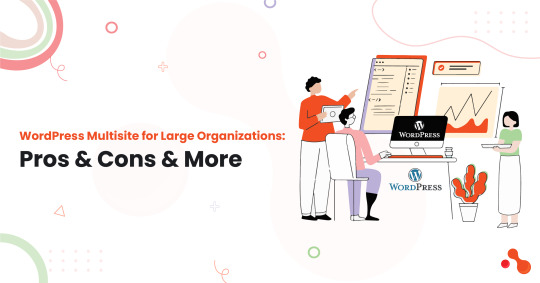
Large organizations often face the complex challenge of managing a multitude of websites. From corporate portals and internal intranets to regional sites, campaign microsites, and brand-specific showcases, the digital footprint can be vast and varied. Managing multiple websites is no easy task. WordPress has the ideal solution for this in the form of WordPress Multisite. Multisite is designed to manage multiple websites from a single installation. However, before you rush into installing WordPress Multisite, it is important to learn more about the technical pros and cons. This article provides more information on the factors to consider before implementing WordPress Multisite for large organizations.
What is WordPress Multisite For Large Organizations?

As the name itself suggests, WordPress Multisite is a feature that allows you to run multiple websites from a single WordPress installation. What this amounts to is that there is one codebase, one dashboard, and one update process to manage multiple sites. The following sections provide more information on the WordPress multisite pros and cons to help give a better picture if it is beneficial for your organization. "Think of it like managing a fleet of websites, the way an airline manages planes. Each one has its unique destination, but they all operate from the same centralized control tower.” — Marta Jansen, Enterprise CMS Consultant.
The Pros of WordPress Multisite
Centralized Management Saves Time and Resources: Multisite solves the problem of managing multiple websites by allowing network-wide updates and configurations. A single admin can push updates to all sites, install plugins once for all, and manage user access across the board.
Shared User Base and Permissions: One of the standout features is unified user management. A single login can give team members access to one or more subsites, depending on their role.
Consistent Branding Across Subsites: Maintaining brand guidelines across multiple sites is easy with multisites which allows you to apply the same theme across all sites.
Cost Efficiency at Scale: Multisite reduces hosting, maintenance, and development costs. Instead of paying for multiple hosting accounts, you run everything from a unified instance.
Plugin and Theme Efficiency: Plugins only need to be installed once and can be activated per site. This reduces redundancy and ensures all plugins are kept up to date from a single control point.
Streamlined Updates: It eliminates the need to install a WordPress security patch or update a plugin in 50 to 100 different WordPress installations. It drastically reduces the administrative overhead.
The Cons of WordPress Multisite
One Point of Failure: The biggest drawback? Everything runs from a single WordPress installation. If the core site is compromised, all subsites are at risk.
Complexity in Plugin Conflicts: Not all plugins are Multisite-compatible. Some plugins may work on one subsite but create issues across the network. Increases level of complexity and hinders long term support especially for non-technical teams
Limitations in Server Resources: Multisite is resource-intensive. Each site within the network shares the same memory pool, CPU, and database. This can lead to bottlenecks unless infrastructure is properly optimized and scaled.
“Multisite is like a high-speed train—smooth and efficient, but if you don’t lay the right tracks, derailment affects everyone.” — Karan Patel, Sr. DevOps Engineer
Limited Granular Control: Certain admin tasks are only available at the super-admin level. If different departments or business units need independent control over core settings, Multisite might feel restrictive.
Migration Challenges: Migrating a single site out of a Multisite network is complicated. Whether it’s due to a rebrand, restructuring, or platform switch, extracting and migrating data cleanly takes effort.
When WordPress Multisite Makes Sense
Having obtained essential information on the pros and cons of a multisite, it is likely you are looking for the best WordPress developers. However, it is important to verify whether such a website fits your unique business requirements.
Here are some of the main scenarios when it makes sense:
Universities or Colleges with many departments or faculties, each needing their own microsite.
Franchise Businesses that want brand consistency but localized content.
News Media Companies are running city-specific portals or vertical brands.
Government Entities managing multiple programs, regions, or initiatives.
NGOs with Global Chapters that want localized messaging but centralized control.
There is a strong desire for centralized control over branding, security, and updates.
When to Think Twice About Multisite
Each site requires a radically different designs, plugins, and performance.
Each site will be managed by entirely different teams or hosting providers.
There is a future need to migrate sites independently or experiment with different CMSs.
You anticipate scaling with isolated environments for compliance or risk management.
There are stringent security requirements that necessitate complete isolation between different web properties.
Technical Considerations Before Committing
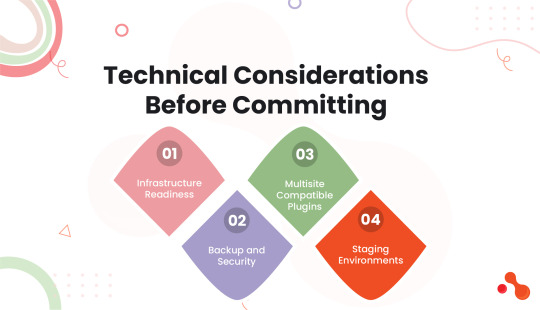
Infrastructure Readiness: Ensure your hosting environment is robust enough to support shared server resources, scalable storage, and high I/O traffic. Opt for managed WordPress hosting providers that explicitly support Multisite.
Backup and Security: Implement real-time backup systems and network-level security firewalls. Always use isolated database tables for mission-critical data.
Multisite-Compatible Plugins: Verify the plugin you select supports network activation.
Staging Environments: Test updates, plugin installations, and new configurations in a staging Multisite instance before applying them network-wide.
Is WordPress Multisite Right for Your Organization?

WordPress Multisite is a powerful solution, but not a silver bullet. It works best when the needs of your organization include:
Uniformity in design and branding
Centralized plugin/theme control
Shared user base and permissions
Cost-effective scaling of multiple microsites
However, if independence, varied tech stacks, or siloed hosting strategies are key to your strategy, you may need to explore alternatives like headless CMS, distributed WordPress setups, or micro frontend architectures. Hire WordPress developers for multisite setup. Consult a WordPress website development agency like Acquaint Softtech for a professional opinion.
Conclusion
WordPress Multisite brings several appealing features like centralized management and reduced maintenance effort. It is also cost-efficient and saves valuable time.
However, there is more to implementing WordPress Multisite for large organizations. It requires careful consideration due to the inherent complexities that it comes with. It also introduces several restrictions and limitations.
Ultimately, the decision between implementing a WordPress Multisite network or managing separate installations for a large organization is a strategic one.
Consult a professional WordPress website development firm like Acquaint Softtech first to avoid making a costly mistake.
FAQ
What is WordPress Multisite and how is it different from a regular installation?
WordPress Multisite is a built-in feature that lets you manage multiple websites from a single dashboard. Unlike standalone installs, it shares the same core files and user base, offering centralized control.
Is WordPress Multisite suitable for large enterprises?
Yes, it can be ideal for enterprises managing multiple regional or brand websites. However, it requires proper planning, hosting, and governance to avoid performance or scalability issues.
What are the security concerns with WordPress Multisite?
Shared core files mean a vulnerability in one site could affect all. Multisite setups require stricter role management, plugin restrictions, and hosting-level security hardening.
Can I migrate from Multisite to individual WordPress sites later?
Yes, but it's complex and time-consuming. It's best to start with a clear roadmap and long-term vision before opting for Multisite.
0 notes